#In That It Was FINE And Contained UNDERSTANDABLE And REASONABLE ACTIONS?????? Based On The Narrative As A Whole?????????????
Explore tagged Tumblr posts
Text
Beginning to suspect some of y'all have never heard of the sunk-cost fallacy
Or if you have, you've never applied it to the media you choose to engage with
#Not Gonna Tag The Fandom That This Is Currently About#But Like#Some Of Y'all Need To STOP WATCHING JFC#There's A Reason I Still Follow The People I Follow#And It's Cuz They Took A Hard Look At How This ~Particularly Long-Running Story~ Was Going#And Went “Nah I Don't Think THIS Campaign Is For Me Thanks Tho”#Then Quit Out To Continue On With Their Lives Without Investing Hundreds Of Hours Into It#And Then Went On To NOT Watch It Bitch About It Or Assume Things About It Based On Fandom Info And Not Actual Cast Info#Wild That This Is A Novel Concept In 2025#Anyway I Apparently Have A Few ~Controversial~ Opinions About The Last Episode#In That It Was FINE And Contained UNDERSTANDABLE And REASONABLE ACTIONS?????? Based On The Narrative As A Whole?????????????#I Think Y'all Are Just...Presuming Facts Not In Evidence And Ignoring Some Of The Words LITERALLY Coming Out Of Cast Members' Mouths#But What Do I Know I've Only Watched With My Own Eyes The Actual Episodes And Now The Added Extra Content For Subscribers 🙄🙄🙄
10 notes
·
View notes
Text
Black Book is a near-masterpiece.
"I give it a 9.5" -- IGN
Black Book is a narrative card-battling/deck-building game based in Russian Slavic folklore. You play Vasilisa, a young woman whose lover has died. She seeks to break all seven seals of the black book in order to make a wish to bring him back, as legend tells she can. I spent 43 hours completing the game.

The Good
Black Book does a great job of presenting Slavic folklore to the player. The proper Russian words are used for many elements: the zagavor, the izba, chorts, rusalka, banya; these are words I'll remember, and it was good for the developers to stay true to the roots. I never felt like I was confused by the usage of these words, or traditions that were evident on-screen. It was clear that the developers spent a lot of time researching lore and mythology. Black Book isn't the type of game for the player to skip dialogue. You're often presented with questions and riddles that test your knowledge of the mythology, and everything they'll ask has been delivered to you prior. The book contains entries for anything you've learned, given as you learned them. I read every entry; the ones in the final chapter are some you don't want to miss.
The game is surprisingly long. I typically trust How Long To Beat and go by the completionists' reported times. I played on hard difficulty and typically took my time, exploring "every nook and cranny" as I always do. I clocked in over 8 hours more than the other completionists.
But there's good reason to replay: while you will get the same linear journey each time, the details of how you played are important. Which characters were by your side, who's alive and not, who shows up later at a bonfire; the game never lets you forget that your actions had consequences, both good and bad.
Black Book delivers. It's fair to say in gaming, I've gotten used to being unable to sock it to some jerk boss, or conceivably unconquerable foe, with the game handling their demise in some other way. In Black Book, you're always given the chance to say: nah, your deal sucks, not compromising, time to die. The player's reward is a tough boss battle that also fits thematically with the boss; all I will say is Chapter 7's bosses were some of the more memorable boss fights I've had in years. They were entirely optional and allowed me to skip a short set of trials.
The ending also delivered. I'll admit by 35 hours my interest was starting to wane, but I was absolutely hooked with the end sequence of chapter 6 and beyond.
It keeps itself fresh, introducing periodically introducing new mechanics both via new cards, and in-battle mechanics such as koldun and puzzle fights.
The Bad
Durak was a miss for me; I appreciate that they wanted to include a card game from their culture, but the rules were confusing and I found it to be more of a distraction in an already long game. It didn't have the up-front enjoyment of Witcher 3's Gwent. It actually subtracted from the experience because there are items and skills built to allow you to cheat in it.
I didn't feel connected to the lover at all. He was clearly a plot device, despite a short segment where we experience Vasilisa's pain of losing him once again, where she reaffirms her dedication to him. Honestly, I thought Alexander was a fine chap and would have liked to spend eternity with him.
Often enough, the (excellent) narrator and words on screen don't match up. You can tell the English-speaking voice actors offered some direction upon delivery of their lines. It was a bit distracting, but my understanding is the game is best played in Russian and the writing was solid enough that I could forgive it.
There's an investigation segment which could have been done better. It was slightly buggy and a little hard to follow. My pick wasn't even an option in the end, and the person I least expected was it. This was a system constraint; they just needed a better system for this chapter.
Money became irrelevant around the 4th chapter. As a completionist, it's not uncommon for me to accrue resources and become overpowered, but I felt like some end-game gold sinks would have been warranted. I was disappointed that in the final dramatic chapter, no new items were offered (that I could tell).
Damage calculation could have been done better. The game requires you to calculate accurate damage any time you're doing AoE because it sums that AoE damage. This is a common complaint with the game and I'm not sure how they released a battle-focused DLC without addressing this!
Chort management seemed annoying; I ended up going for a sinless playthrough, so I didn't have to assign them constantly, but I can imagine how annoying it would have been to do so.
All in all, I would still say it was nearly a masterpiece. It achieved what it set out to do, imperfectly in small ways, but it was everything it had to be. The Russian voice acting cast is about three times the size of the English one, and I can only assume the story was delivered better in proper Russian. I would recommend any Russian gamer to play it, and if you like the good points I described, give it a shot on sale. I personally got it through a Humble Bundle.
9 notes
·
View notes
Note
I feel like it would be better if everyone could just concentrate more on the projects GGDD are bringing out ( SDC and OOL for example) and less on political issues that's out of our hands. More of that positive engagement is what we need
If you prefer to look away from politics that is your right, but that's not something you have the right to ask of others. Especially considering that I tag every political post that I make, so there's no excuse for people seeing things they don't want to see (if you want to avoid political posts from my blog you can filter the "your political disengagement is a weapon against you" tag).
You have created a false dichotomy here anyway, because people are focusing on both. People are enjoying and loving GG and DD and their projects, while reflecting on politics surrounding them.
I believe personally that in order to have a truly balanced and healthy perspective on GGDD one must do both. However, not everybody is up for that emotionally or psychologically, and that's totally fine too.
I'm going to go over some points that I made about this topic a while back. This is a slightly revised version of what I've said in the past. I hope after reading this, Anon, you can understand why I don't find the approach you've proposed acceptable.
“BXG should stay away from politics”
While I understand some people get involved in fandom strictly for the enjoyment and escape, I don’t think it’s appropriate for those people to try to dictate how others approach things. As a politically-minded person, the idea of ‘staying away from politics’ - especially the idea of pressuring others to stay away from politics - goes against some of my most deeply held values.
There are also some fairly glaring problems with the idea that BXG should stay out of political discussions.
1] Making it socially unacceptable to care about politics is a means of ensuring people remain uninvested in what happens in the world.
��Politics’ is a word that is often used to emotionally distance people from things that directly impact them. Labeling social issues as ‘politics’ and then making 'politics’ a dirty word is a psychologically manipulative practice that frames important, life-changing issues as tedious, negative and inappropriate pursuits. People might as well be saying, “Don’t trouble yourself with how the world is run, with how people treat each other, with what you’re allowed to do, say or think, with who is in charge of things or what decisions and actions they impose upon others.”
How convenient for the powers-that-be. How convenient for the status quo. A population that has a distaste for 'politics’ has a distaste for concerning themselves with their own interests. A population that has a distaste for politics will not only avoid thinking about how things are run, they will dissuade - often vociferously - other people from thinking or talking about those things as well.
When you make it socially unacceptable to think about issues that matter, you ensure that the people will never really question what’s happening, or demand change. You will ensure that people do not inform themselves or reflect on and develop their own ideas and values. You will ensure that people who try to stand up for themselves in a broader way will have little support, and will face bullying and stigmatization for their efforts.
2] Disinterest in politics reflects a level of privilege a lot of people don’t have.
When an issue of injustice comes up and someone’s response is, “I don’t want to talk about politics,” or “Let’s try to stay away from politics” in a very real way the message they are communicating to others is, “Whatever is happening to those people, I don’t care. My conversational discomfort in this moment is more important than the injustices those people are dealing with.”
The fact is, our actions and choices are inherently political. They reflect and often reinforce the sociopolitical structures we live within. The purchasing decisions we make, the media we consume, the ideas and policies we legitimize via our behavior - all of these things are political whether we know it or not.
The big difference between thinking of ourselves as political and thinking of ourselves as not political is that apolitical people are able to move through sociopolitical structures completely unconsciously, while others don’t have that luxury. Poor people, racialized people, immigrants, targeted minorities - none of these people have the luxury of ‘not caring about politics’. Their lives often depend on being deeply invested in what happens in the public and private sphere.
If you’re able to ‘not be interested’ in politics then you are a fortunate person indeed.
To people faced with injustice and inequality, politics can often be a question of their very right to exist, let alone thrive, in this world.
3] Editing politics out of discussions about GG and DD is a lot like erasing their queerness. It adapts them into a narrative that, while it may feel good for some fans, isn’t real.
It may make some fans more comfortable to edit out the parts of this fandom that are confusing or unsettling, but fans who prefer their perspective to be balanced and based on reality will just have to accept that this fandom will sometimes force us to reflect on things that aren’t so pleasant.
GG and DD are living under an authoritarian regime. They are frequently called upon to perform and present propagandistic ideas and projects. All of this just goes with the territory. If we refuse to explore and understand the political elements surrounding GG and DD we will be missing important context about them and and their lives.
The politics are relevant to the fandom. They are relevant to what we discuss, how and why. They are an inextricable element of GG and DD’s lives, and that necessarily makes them an inextricable element of any meaningful discussion of them and what they do.
4] If you share their propaganda posts and projects, you ARE being political.
I really feel the need to point out this obvious fact, because there appear to be some people who really don’t get it. GG and DD’s propaganda posts and projects are inherently political.
It is hypocritical and unreasonable to spread that propaganda and then tell people not to discuss it.
Having said all of that, there are simple ways to co-exist even if we disagree.
There are a lot of reasons why people participate in fandoms, and not everyone is in a mental or emotional place where they want to be exposed to political discussions, which can be stressful. Fandom can be a form of escapism, and a way to enjoy something light and fluffy without having too look too closely at the cracks in the facade.
That is a perfectly legitimate position to take on things, and people who don’t want to take part should be free to filter those things out of their feeds. Tagging political or stressful posts is a must.
However, what isn’t legitimate is telling other people that they shouldn’t be thinking about it or discussing it, or claiming that it doesn’t belong in the fandom. Respect needs to work both ways, and space needs to be given for people to pursue fandom in the ways that work best for them.
BXG are a broad category of people with a broad range of interests, motivations and needs. It is possible for all of this diversity to harmoniously coexist, but that means respecting each other and working together. Tagging posts that we know some fans would rather not see is one excellent way of doing this. And that includes tagging posts that contain propaganda messages or projects, which can be offensive or triggering for people who have grown up under authoritarian regimes.
***
I also want to add a personal note here.
There are a lot of troubling things happening right now. A lot of people are feeling unsettled about it. One of the main ways in which people process and come to terms with difficult experiences is through talking about it and exchanging ideas with other people who care. It would be a huge disservice to a lot of fans who are struggling with what's happening to say, "You're not allowed to think or talk about this. Let's focus on other things."
One of the primary purposes of my blog from day one has always been to try to be supportive, particularly of marginalized people or people who are dealing with adversity. I want my blog to always be a place where people can feel safe to talk about the things that are on their mind.
#your political disengagement is a weapon against you#brotherhood and stuff#bxg perpectives#fandom reflections#ask
51 notes
·
View notes
Text
To talk about Twice and villainy is to talk about class and criminality (I)
(Masterlist)
In contrast to the fantastical world that surrounds him, Bubaigawara Jin’s backstory, revealed in chapter 229, is completely unexceptional. Jin’s backstory is about class. Throughout this series, a sci fi fantasy where almost all the cast have superpowers, we are introduced to characters who’ve struggled with their Quirks, whether having one or not having one, whether having one that’s powerful or weak, whether they have Quirks that are stigmatized or not. Most of the series handles its sci fi prejudice in this way, by substituting real life characteristics like ethnicity (hero Ryukyu is of Ryukyuan ethnicity and from the colonized Ryukyu islands [source]), gender-based discrimination (including misogyny and transphobia), ability (Aoyama, Dabi, and other characters to a lesser degree have physical difficulties using their Quirks), and stigmatized physical traits (as several mutant characters mention being discriminated against) with Quirk conflicts. Ryukyu’s ethnicity, Rock Lock’s race, Magne’s transness, all the misogyny, and the real life disabilities of many characters who are missing limbs are given minimal or no attention, as these conflicts are replaced with Quirks-as-metaphor.
In this fantastical world, where we’ve supposedly left behind our prejudices about race and ethnicity, gender, disability, and so forth, and replaced them with prejudices about Quirks and Quirk compatibility, Horikoshi made the decision to make Jin’s backstory about class as we understand and live under it today. His backstory stands out as one that is utterly banal. Although Jin’s Quirk comes in later, it’s hardly the driving force of his struggle, because what he’s faced with is simply the unfeeling machinery of capitalism and the state apparatus. There’s no involvement from Quirks or Quirk society here; the world that starts Jin on his downward spiral is one that’s inextricable from our own, one that any of us (some more than others) are vulnerable to. That is to say, he didn’t become a criminal because he had an awesome Quirk that made him egotistical (or whatever people think criminals are motivated by), he became a criminal because his circumstances left him with few other ways to seek fulfillment, and possibly to survive. His Quirk was only a balm to the harm already inflicted on him by the economic realities of futuristic (and simultaneously contemporary) Japan.
A quick recap of Jin’s backstory from chapter 229: His parents, due to a villain attack, died when he was in an unspecified year in middle school (it seems ironic, and another example of BNHA’s cyclical events, that Jin himself eventually dies at the hands of a hero). At 16 years old, Jin was already working. He got into a traffic accident, although he was obeying the speed limit, and broke someone’s arm. His case was prosecuted and likely resulted in a record, but the officer in charge suggested that he may be able to “bounce back”; however, the person injured in the accident turned out to be one of his workplace’s clients, and the clients’ outrage resulted in his termination from his job. Eventually, isolated and lonely, Jin used his Quirk to become a villain, and it’s implied in the depicted panels that he mainly stole. An indeterminate amount of time after becoming a villain, Jin’s clones turned on one another, resulting in a bloodbath that traumatized Jin and resulted in split personalities. After this incident, he turned to Giran for help, who in turn introduced him to the League of Villains.
Systemic barriers
So why couldn’t Jin bounce back, as suggested by the officer? The reasons are many and diverse, not all of them stated in-text. I believe Jin’s specific circumstances merit some evidence from real-world Japan today, since there’s no statement nor implication that these things have changed in these respects, and because this is the frame of reference that Horikoshi and many of his readers are working with. In order to tap into the spirit of the work, it requires an examination of the circumstances and conditions under which the writers are creating, a recognition and acknowledgment of the social issues that may have shaped and influenced their outlooks. Thus, I think it’s important to contextualize Jin’s past not simply as a self-contained example of inequality in BNHA, but as a narrative that ties into the societal concerns of real-world Japan.
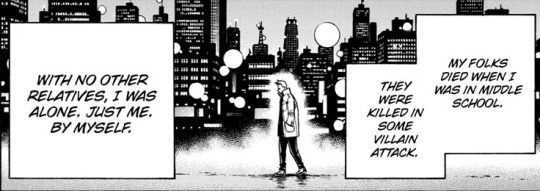
The alternative care system.
This describes the system of institutions and fostering that cares for children who are unable to live with their parents (whether it be due to circumstances like neglect and abuse, or because of the parents’ deaths). In 2014, nearly 90% of children in alternative care lived in residential facilities as opposed to with foster parents (which has its own issues); these rates are much higher than in other industrialized countries, which mostly rely on the foster care system. Residents of the residential facilities report strict rules, child abuse, and bullying. [source] Usually people age out at 18, or even earlier at 15 if they choose not to attend high school. Requests to extend alternative care until an individual reaches 20 are usually denied. [source]
The economic outlook for individuals aging out of alternative care is not optimistic. “Once individuals lose their access to staying in an institution, combined with low wages for menial entry-level jobs, many young people cannot stay on the same job that the institution helps them find when they leave institutional care. If they leave that first job, they struggle to find another[...] Those who start working straight after graduating from junior high school and are forced to leave their institutional care facility may be at a particularly high risk of becoming homeless.” [source]
What does this mean for Jin? Since his parents died when he was in middle school, it could have taken place any time between the ages of 12 to 15. Jin was already working at 16 years old, which according to our information means he dropped out of school and no longer has government-provided accommodations. Depending on when during that middle school time window his parents died, he could have possibly not even entered into the alternative care system at all, entailing that he started to work right after their passing. Either way, Jin most likely quit school and started to work to support himself at 15 years old, forgoing high school and college, taking responsibility for his own shelter, food, bills, clothing, and so on. At an age when the UA kids are just beginning the best times of their lives, making friends, staying in the school’s dormitories, Jin was literally trying to survive on his own.
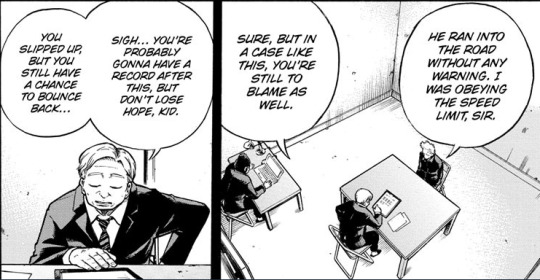
Criminality.
This is a bit harder to pin down, and there aren’t many English-language sources regarding criminal justice studies, and very little that thoroughly breaks down the process. For details that we might want to know about, such as arrests and convictions according to race, ethnicity, class, mental illness, etc., those are even more lacking (possibly also in part due to Japan’s low crime rate). I’ll do my best to sum up what I do have, and maybe someone can correct me on this. Anyways, starting from the basics:
The motorcycle accident that Jin was involved in, which injured another party, is a prosecutable crime punishable by up to seven years in prison or a fine of up to one million yen. [source] Just to cover all my bases, yes, at the time of the accident, Jin was indeed a minor under Japanese law (although within an age bracket where he theoretically could be assessed and/or tried as an adult), [source] [source] but we’re not sure if/to what degree that was taken into consideration. Either way, the outcome is that Jin likely ends up with a record, according to the officer (or possibly prosecutor) who’s speaking to him. From what I can make out, getting a record from a traffic accident with injury means he was charged and probably went through summary proceedings in the lowest court, [source] though I’m unsure how this whole process would work if his status as a juvenile was taken into account.
There are a few things to point out here:
Arrest and detention (which I’m assuming is the lead-up to that conversation with the officer) are notoriously lengthy and pretty rough. [source]
Prosecutors have significant discretion in what gets pushed through to see charges and what gets dropped. This is one of the reasons, possibly the main reason, for Japan’s 99% conviction rate—prosecutors usually only press charges in cases that can bring about conviction. They can even take into consideration someone’s age, character, circumstances, etc. when deciding whether to prosecute or not. [source]
During this process, when someone is hurt in an accident, there’s a pretty big deal made of apologizing and offering compensation to the harmed party. These actions are viewed favorably when it comes to case review and sentencing, while arguing over fault and general disagreeableness hurts the case. [source] [source]
(PS: The line “you’re to blame as well” makes sense in the Japanese legal system as a facet of comparative negligence.)
(PPS: Given the ongoing debates over juvenile justice—the likes of which inspired Battle Royale—I wonder if the rather harsh results of Jin’s first encounter with law enforcement are also meant to be read more deeply?) [source; cw for child murder in link]
At this point, we have the question of whether or not Jin’s possible record impacted his inability to “bounce back.” This was also pretty difficult to find information about, and the answer is... maybe. While criminal records are held by the police, and prospective employers cannot access them, this is usually sidestepped by asking applicants to provide information about their own criminal records on a CV template (whether or not people do, or can even legally lie about this, and whether or not they can choose not to answer without impacting their chances of getting hired is not information I was able to find). [source] A certain stigma towards convicted criminals does exist, despite the criminal justice system’s prioritization of reintegration over punishment, [source] though as for further information about whether a record impacts someone’s employability and quality of life doesn’t seem to have been studied. Real world Japan’s declining recidivism rate, though not declining as fast as first-time offenses, seems at least to suggest that even individuals with a record can successfully reintegrate into society, [source] hence the officer’s suggestion that Jin can “bounce back” is not totally bizarre, although it proves short-sighted.
These details illustrate the odds of what Jin is up against. They raise the question of why prosecution didn’t go differently, and they highlight the vulnerability of a parentless child up against the legal system. Jin, again, a 16-year-old (who also doesn’t appear to have legal counsel in the depicted panels), obviously argues his responsibility in the accident; furthermore, he’s unlikely to be able to fulfill the social graces required of a lenient case review. As a teenager who’s already working to support himself, without any family to lend a hand, he likely wouldn’t have been able to muster up the finances for compensation, medical expenses, property damage, etc. at a moment’s notice, and even in installments the payment probably would’ve been a strain. For example, the possible fine of one million yen is half the annual income of Japanese households which fell below the de-facto poverty line in 2008. [source] It seems plausible that his inability to see through the proper courtesies resulted in an unfavorable assessment, and a prosecution carried through to the end. We don’t know for sure how he was sentenced—judging by his return to work, it’s likely he didn’t do jail time—but even assuming a lenient sentence, this accident quickly catches up to him. With no one to fall back on, and no one to cut him some slack, a stumble quickly becomes a fall.

Employer-employee relations.
The relationship between an employer and employee is one rooted in a power dynamic, where one side controls the time, the wages, and often the health of the other. A job and its benefits are usually the deciding factors of someone’s quality of life, so employees will work overtime, work while ill, and suffer any number of abuses to keep their jobs. Overwork, and the resulting health problems from overwork are enough of a crisis in Japan they’ve been named karoshi—death from overwork. The effects range from general, stress-caused health problems, to heart failure and suicide; what gives rise to these conditions are a complex mix of work culture, company culture, and common hiring practices. Essentially, workers are encouraged to present a loyal face to their company, and because of the structure of the job market, changing jobs isn’t easy. [source] [source] These facets of work culture also contribute to power harassment, an issue that has received growing visibility in the past decade. In 2019, 37.5% of surveyed workers reported suffering power harassment, often from bosses, including receiving excessive demands, degrading treatment, invasions of privacy, and sometimes physical abuse. [source] [source]
This drastically imbalanced relationship only receives a few panels in Jin’s backstory, but that’s all it takes to make the power dynamic clear. Within three panels, Jin’s boss assaults him, berates him, and takes away what he knows is the only source of income for a working-class 16-year-old with no family. An accident that happened is equated to an act of disloyalty because the wrong person was injured, which reflected poorly on the company Jin was working for; however, a double-standard exists. While Jin’s loyalty to the company is expected, there’s no reciprocal expectation for the company to care for the wellbeing of its own workers, instead prioritizing its image and its bottom-line. Employees can be fired at their boss’s whim, leaving the terminated party without an income nor benefits, looking at breaking into a job market that is intolerant of repeat job-seekers—even more so if the individual is someone without a lengthy employment history and without a higher education. This short interaction highlights the precarity of financial stability, where a termination from one job on one man’s authority can leave someone—even a kid—without any way of coming back and achieving a steady living.
120 notes
·
View notes
Text
Part 2
This is part 1.
Can you tell how tired I was getting by the end? This is life under meds, but given the other benefits (I think?), I’ll take it for now.
When I woke up the next morning, I had a whole lot I was thinking about and it’s stuff I want to say given I said a lot, but didn’t cover this stuff. I’m still happy with part 1, I think that’s just how I write, moving from subject to subject more or less organically and it does show me to more unstructured even if there is a vague plan for how I want the piece to go.
Anyway let’s get going.
As always, mild spoilers for well, everything. If you haven’t seen this stuff and are mildly interested in watching them then ah, you may have a lot of catching up to do. I don’t think I’ll drop any real hard spoilers for anything but you never know.
Ghost In The Shell is an Outsider story
There are whole stacks of lore you could dive into with Stand Alone Complex in particular, with Motoko having been in an aircraft accident and getting her first shell (cyber-body) at a very early age, what that means, the thing with Kuze (avoiding spoilers here), and the extended cast - not that Paz, Boma and even Ishikawa get a whole lot of time anyway - but it’s not really that important.
Looking at just Mamoru Oshii’s 1995 film, and even more-so his 2004 film Innocence (not really a sequel but usually regarded as such), the narratives cast the characters very much as Outsiders. In the first film, Section 9 is already at odds with the government in general and while it’s subtle, Aramaki as a department head is certainly different from his contemporaries, even if we don’t see much of it - again, so much more of this in Stand Alone Complex. Motoko’s early conversation with Togusa in the first film is probably the most telling as far as playing it loud. She speaks in pragmatic terms to why he’s there, but this is a precursor to what will ultimately transpire for herself at the conclusion of the film, something very intentionally written into the film. Batou is also an Outsider in more ways than one, not only in the role he plays in the department but in the very clear personal boundary between him and Motoko. There are boundaries between Batou and everyone and they become more apparent in the second film. Togusa is easy pickings so I’ll leave him alone, suffice to say if the film needs one, he’s the audience’s window of ignorance which is why he’s discarded so willingly half way in. He gets his time in the spotlight in Stand Alone Complex and it’s pretty amazing.
As for Motoko... I admit it is difficult separating my understanding of her character from Stand Alone Complex and attempting to just isolate what’s shown of her in the first film but I’ll try.
I mentioned the film’s centrepiece montage in my previous journal, in which we might say Motoko is the centrepiece but if so, she probably shares it with the city itself, and I feel much more is being said about the two together rather than separated simultaneously. This would be one of the first indications of Motoko’s sense of identity, of otherness, isolation, questioning. Again the scene that plays it most loud would be diving on the boat and her speech to Batou. There are other moments tho; single frames of her face, looks, movements that are lingered on, I feel like Oshii is constantly telling us about her and what she’s going to do, but more important than that, why she’s going to do it and how she feels.
Ghost in the Shell is a film about great emotion, and not like I’d know because it’s been a long time since I’ve looked into the discourse around it, but I suspect no-one really talks about it as a film about feelings.
I realise these days I talk more and more about moods and art being mood pieces. I labelled my Instagram account as being “A catalogue of moods” and I’m very fond of the use of the word in vernacular. It might seem flippant but it’s immensely empowered, especially for me as an individual when I understand my moods and can translate them into, via and thru art. I do appreciate many struggle with Oshii’s cinematic language as it can appear cold and detached and that’s fine, but it’s anything but for me - it’s immensely emotionally charged, it just appears differently to what audiences are perhaps accustomed to seeing. It’s a different language that perhaps takes time to learn, but it’s all there.
This couldn’t become more evident than in Innocence (the Ghost in the Shell 2 moniker I think was a western addendum). Batou takes centre stage and is immediately presented as bluntly as possible as an Outsider, reaffirmed later by Aramaki who also cements Togusa’s position in limbo.
I should pause and say that within the GitS canon, I feel Togusa is definitely embraced by Section 9, so he’s not wholly an Outsider to the department, but for obvious reasons, he doesn’t fully share all of their daily or philosophical concerns - hence not wholly. He would also definitely be an Outsider to most other members of the force after joining Section 9, but unfortunately I’m not here to love Togusa, poor guy - I feel like he’s always a bit unloved. Someone write a giant essay in service to his greatness. He actually is great.
But I adore Batou in Innocence. I love his story, his struggle, his emotion. I love how present Motoko is without ever appearing on screen and then when she does, the impact she has on everything, especially with the lines she delivers, one of which I quoted to open the last journal. Batou is in many ways a shadow of what Motoko was and is/has become, just in physical form, mirroring her in a real world manifestation with the natural physical limitations that comes with.
For some reason I feel like I need to inject a comment about Batou putting the jacket/vest on Motoko’s body. I don’t know if people perceive this as an act of masculine modesty but it’s not how I read it. I did stumble on this action for years but as I began to interpret the films as Outsider stories, I realised that he does this as an act of inclusion, and that Motoko consents, permits him to and doesn’t immediately react with violence or technological recourse we know she is well capable of, indicates it’s mutual. Their inclusion isn’t just about the boundaries of the Section 9 department but extends beyond that, an inner circle that may only contain the two of them - inside which there are still boundaries between them Batou can never cross. Those boundaries become infinitely more apparent after the final events of the first film, and the second film effectively is all about how he feels about them. He is an ultimate Outsider, but so is Motoko in the state she now is in.
Section 9 is a department of stray dogs. Individuals who haven’t quite fit in where they belong, and found belonging with one another. Then, after a time, one of them moves on - at the conclusion of the first film, and then another feels an almost permanent and ultimate sense of separation - more or less the duration of the second film.
Ghost in the Shell isn’t about technology and sentience and hacking and corporations at all. It’s about loneliness and belonging and acceptance and affection. It’s about how that feels.
I’m Not Sure Why People Struggle With David Lynch Films
I need to stop talking about anime. Honestly I looked at the list at the start of the last journal and thought hell yea Sky Crawlers, Jin-Roh, Haibane Renmei and Lain let’s unpack some shit! but honestly I’ll run out of time and I should really draw from a variety of mediums and sources.
OK I’m not being facetious when I say Lynch’s films are fairly straight-forward narrative-wise. Again, it’s hard for me to position myself in a place where I’m not into the stuff I’m into and maybe that’s what gives me the cinematic language familiarity to parse them but that just sounds like wanker bullshit to me. I don’t mind if folks don’t like Lynch films, that’s fine. But they aren’t difficult.
So in the context of everything else, even on that short list on the last journal, plus how I keep trying to shift the discussion of works from the pragmatic reading of them to an emotional reading of them from a mood perspective, I feel as tho the same process can be applied to Lynch. So much about his films are about how they make you feel, or I’ll say - how they make *me* feel. It might be grandiose to assume I’m feeling the correct emotion, that these are the moods that David Lynch himself is attempting to create and evoke and thus, I am interpreting them correctly but hey - I enjoy the hell out of the films, feel I understand them and watch them over and over again so that’s all I’m basing it on.
That’s not to say there are things I dismiss as meaningless or that I don’t understand in his films, it’s just that I don’t have to parse them immediately at first watch and perhaps that’s the audience’s problem. I don’t know if reverse-diagnosis is appropriate but looking at how much hand-holding there is in other directors’ films might be just as telling. I mean I saw Nolan’s Tenet and was about the least confusing thing I’d ever seen in my life but apparently *that* confused people, and you know hey that’s fair I guess, but I mean Nolan did a whooooole lot of audience hand-holding in that film, I mean, the dialogue was terrible. There was so much unnecessary exposition, which I generally find in all of his films, so if an audience can’t follow that then OK sure, Lynch is going to be a problem.
The thing is popcorn cinema is totally OK. I watch it. I really love it, I’ve written about it before, it’s good Industry. There’s a lot of great creativity in popular cinema, I don’t at all think poorly of it and I love seeing a really well produced, Hollywood picture... but I guess if that’s all you consume, and I guess if folks’ short-format episodic media (aka series - think Netflix, HVO etc.) is more or less to the same standard, then it begins to make sense that anything outside of that isn’t going to make sense.
Long story short - Lynch films tell simple stories where the feeling of the film is as important as the narrative of the film. To understand the story, you have to understand the feeling, and vice-versa.
Surprise surprise, it turns out independent and deemed “fringe” film-makers... aka Outsiders... make films about Outsiders.
Now I wouldn’t know if any of the Marvel films thematically are about Outsiders or Outsider culture, they probably are and very loudly at that, but the reason I’ve never included one in my catalogue of moods is they all read the same way. Not only are Marvel films mostly indistinct from one other to me, they’re also mostly indistinct from much of popular culture in general. That doesn’t make them bad, some of them still have some pretty awesome stunts, visfx, even parts of the narratives, funny jokes etc. in them, but on the whole they’re not useful to me as things I deem truly valuable in the long-term.
It’s OK, I’m not at all going to lament the proliferation of Marvel films, a lot of them have been pretty cool and they keep people in work. Meow meow meow “the death of cinema” mate, sure - I find it more difficult to find the sorts of films I like but that’s always been the case. Humans will do what they do, it’s not a read on cinema, it’s about being an Outsider and what that’s all about. True, maybe weird shit like Lynch and Noe might be more difficult to make, but the weird-indie corner was also dominated by white men and that needs to change, so who knows what the future holds.
Can you detect the point at which I took my meds and started getting tired?
Ghost in the Shell // Innocence // What We Want // What We’re Left With
Growing up as an Outsider, I feel as tho the first Ghost in the Shell film carries the weight of isolation, questions of identity and belonging, ultimately of acceptance, empowerment and liberation. Then Innocence brings to bear very similar moods but states that things may not necessarily change for the better, they simply change state. I love that in both narratives, the main texts of hacking or corrupt corporations, crime etc. are the least common denominators and barely relevant to heart of the films. I think about the theme of icons in Innocence, icons operatively being the dolls throughout the film, and the final image of Togusa’s daughter’s gift. As humans we assume we’re to take the position of biological humanity as representative of sentience, taking moral priority over all other beings. Earlier in the film we think Togusa is in limbo, but at the conclusion Motoko asks the question, or perhaps states that perhaps we’re all in limbo together.
I think that’s a significant part of what growing up as and being an Outsider is like, what it feels like. Christians have this saying about “living in the world but not of the world” (derived from a bible verse) and honestly I don’t think they know what it means because they just operate like a cult, but I think queers and folks with long term mental health conditions have a better idea. We are pushed out to the fringes of our social groups from an early age, long before we know or understand what’s different about us. Our peers and the adults around us do this to us because their social behaviours are so well hard-coded, even they may not even know precisely what’s different about us, they just do - and they’re right. We are different. And they don’t accept us.
Maybe I am starting to get a little more upset that weird/different art is becoming more difficult to fund and make, because it’s for us, for me. It speaks to me. You already have so much, and representation and inclusion is so important. I don’t just need queer cinema, I need weird cinema, I need moods. I need quiet, introspective, pensive, reflective, Outsider moods.
I still feel like an Outsider. I have a few people who understand more about me, but I don’t think I have a place, not in a real sense. I have never felt that. Art is one of the few places I feel any connection with anything, and connecting with people is a very odd thing to consider - honestly, I actually would really like to connect with people but the unique combination of being queer *and* autistic comorbid with bipolar makes it really tough, more difficult the older I get. And now all you want to do is fund Marvel movies. I can’t feed off of that.
I’m getting tired, I’m not making any sense. It’s time for bed.
#2021#chrono#ghost in the shell#innocence ghost in the shell#outsider culture#outsider#queer#queer culture
4 notes
·
View notes
Text
Well I am bored and can’t get back to sleep. So it’s time for a supergirl s5 rant no one asked for.
Now every season has its issues and there were some outside “issues” this season (COVID-19 and Melissa being pregnant) so I will keep that in mind.
That being said.
This season had problems from the word jump. This was for a few reasons.
1- The plot was all over the place
And I don’t mean, ‘oh there was not enough of [blank character] so it was bad.’ No, I mean it was literally jumping between to many elements. Like what was this season about really?
Was it about a new tech environment taking over people’s lives? Was it about an ancient occult power coming out of the shadows to “take” the earth? Was it about adjusting to a post crisis world? Was it about the Luther siblings joining forces to achieve common goal and brainy is a secret inside man?
Now I understand that most tv shows have multiple plot points to follow that’s normal and expected. However, you need to have them meet up in away that is rewarding to the viewer and makes sense for the story that you are trying to tell. And there is an old writing trick called “one step at a time” Basically it boils down to, The audience will only believe one thing at a time.
Eg. You tell the audience this character can only do something in a certain way, (like the sups and the yellow sun,) but then you say that actually never mind this is another way to do it,(like Kara can keep her speed and only her speed under a red sun). This is bad writing as there is no set up or pay off and you cheated your audience by just changing the rules you made for no reason. (Think that kid on the playground that does that “unbeatable force field” thing in a game of tag.)
This can also apply to story concepts this is called a “conflicting narrative” in season 5 this apples to leviathan.
At the start of the season (ep 1 -8) we are told that they are ancient and magical based villains, all good.
and their big plan is to therefor, of course *checks notes* to use advice sci fi tech to achieve their goals and do something? with the people inside, yeah that makes sense what else would they use? Magic? that thing the super family is vulnerable to? Nah.....sarcastic’s aside, if you establish one thing you can’t turn in round with no explanation.
They actually have a good example of this concept working in this season, in ep 10 with Brainy and his changing physical appearance.
It was set up in the ep early on that our brainy was ‘off’ compared to the other Brainy’s, we get an explanation in the bar scene with the Rath siblings and then it is built upon with a Kara and Brainy scene, then after a build up and a reason (a character based one I might add) it is then and only then that it gets revealed and guess what.... that is hands down the best ep of the season.
I literally have re-watched that ep so many times cause it’s that good. It is great self contained episodes and builds on per established character moments and plot points (brainy’s character inconsistency and the crisis plot aftermath) it’s the gold standard of what I’m talking about.
it sets up and pays off what it is trying to do and give character base reason for the story.
But the season as a whole don’t do this effectively because
2- They focus on making the plot the compliment characters, and not the characters complimenting the plot.
the blanket term for this is, this is called “build up and release” this is used to drag out tension effectively. there are 2 ways to do this but basically
1- answer one thing, then that answer leads to another question
2- give partial answers through out a space of time, to keep attention but not make it the only focus of any given moment.
but anyway,
season 5 has this issue where they bring up a point then either don’t carry it through or don’t ‘step it out’ in a way that leads well to the story.
remember what i said about accepting one thing at a time? now let me ask.
If Leviathan is secret why did they reveal themselves now?
I don’t know and guess what, I don’t care, because the show didn’t care either. they never set up why they came out of the shadows or why that even mattered? so why would anyone care outside of “season’s bad guys”.
you know what this season did care about the Luther siblings. there is nothing wrong with that per say, I just don’t see why they needed Leviathan if they didn’t actually want to develop them in anyway. If the post crisis season was just about taking down the Luther’s then fine nothing wrong with that.
but here is why they NEEDED the Leviathan ‘plot’ (and i use that loosely) is that they needed it to justify Lena working with Lex and not have her come off as “too evil” that way she can say
“i’m only working with you because I want to get rid of Leviathan”
instead of
“i’m working with you because i have the same motives as you”
which would not play well in her “redemption” (and i use that term even looser) they kept an aspect to the story purely to complaint a character they wanted a particular outcome, so they kept a plot element around regardless of how well it actually worked with the story.
and then there’s the bitch himself LEX (John did a great job tho tbh)
he is the biggest example of ‘plot fitting character’, Lex didn’t fail ONCE the whole season, no problems or surprises and it was “oh so easy for him” like that is just frustrating for everyone, i’m not saying “the hero’s should win all the time” No, but the villains need to earn their wins to. here is why that is an issue if you make it to easy.
1- the audience wants to see every character have their problems with achieving their goals and how they go about solving the problems as it is and hear me out...entertaining
2- when a character always has things “go to plan” it feels super forced, the Human error, is built into us (the audience) as people, so to see it not come into play at all, at any point, feels fake as we all know life don’t work that way for anyone. especially if there are people actively trying to stop you.
overall you shouldn’t force a plot to fit a character, you should write a character to fit the plot their in (or in other words have them adapted to new situations they don’t even have to do it well)
Ironically a good example of this in s5 was William
they built up that he was a journalist and that he was hiding something, fast froward and it turned out that he was trying to uncover Leviathan (unknowingly to him) and not apart of them.
this is a good way for a character to compliment the plot.
they said here is a new journalist and he doesn’t even know the depths of what he is looking into and that’s a smart move.
i’m just going to leave this clip here...
youtube
this tied in character and plot really well it exampled character and now after this scene they can shift his behaviour and have a reason for it. not just ‘oh actually he was never a jerk and he is nice now’. no it was “he is trying to achieve a goal using this method and now he has been exposed”. This gives a plot based obstacle and character reaction (that failed to work) and it works actually quiet well for a network conspiracy plot.
character completing plot.
and finally
3- Rushed endings
now this one is actually treaty to talk about, cause of well the COVID- 19 problems so i can’t be to judgemental about it cause that is a dick move. And on top of that the lead actress (of an action show) was pageant so they had to use he a little less (in fight scenes anyway) so again I’m not going to be a dick about it, and you know i don’t want anyone being forced to work during a pandemic if its not at all necessary. So, i will keep this brief.
There are still things that fell flat due to being to rushed.
1- the tech/ VR take down.
It was built up for at least 10 eps and they took it down in 5 mins with a pep talk from Kara, like um ok that was easy i guess, don’t know why y’all were worried if you could fix it in an afternoon. this is not a bad plot line in theory, but it was given to much attention for the solution it was given.
2- Leviathan lady (don’t know and don’t care what her name is) being a robot alien thing.
this one is not too bad? but it was shown way to late in the game and again they didn’t focus enough on Leviathan for this to be of any real audience value outside of a surprise/ shock value. So why should i care now? they barely did anything interesting this season but then you give me something cool 2 mins after it doesn’t matter anymore (with the others bottled). why was this not done earlier in the season? but anyway.
3- Lena’s “redemption”
I could write a whole separate rant about this, but for time and my sanity i won’t. but basically, my main issue is that the whole season Lena was spiralling downward and doing worse and worse things to people, and that’s fine from a story pov, but after at least 15 to 17 eps of this and countless bad decisions and judgements she dose ONE good thing and, well that’s all your needed to do, all is forgiven.
now i am all for redemption arcs but one of the main words there is ARC!!!
there needs to be a reflection, apologies, rejections and making mistakes and then truly changing for the better, and still making mistakes!!
it was disgustingly quick and it honestly made me a little uncomfortable. I want to see people grow and learn but people have to earn their own way there. and another thing redemption is not something another person should be reasonable for giving you. (*cough* Kara *cough*) redemption is something you give yourself through hard choices, personal loses and hard work. and guess what you can do all that and still NEVER get back what you messed up, that was real change and growth is as,
redemption, real redemption
comes in the moments when you don’t benefit from it, Lena loses nothing in helping Kara in the end and gains everything she throw away in a minute flat. So, yeah i think it was rushed in a way that made my jaw drop in disbelief because of how badly rushed it was.
But getting out of that head space.
I like trying to end on a positive note the only part of the ending that was not rushed was Brainy’s bottling of Leviathan,
it was set up as a thing that be could do (ep 10),it was a hard choice to make (as it was going to kill him) and was given time to feel the full weight of the choice, the Rath sibling hand hold, then Lex taunting him and taking the bottle, and then Brainy being left there alone, Then a bit of hope with Nia’s vision. it was the best part of the ending this season and i want to see more. that is how you don’t rush an ending let the audience feel the consequences for the character choices with the character.
anyway season 5 rant over.
#brainiac 5#supergirl#legion of super heroes#supergirl season 5#long post#lena luther#lex luther#supergirl cw#nia nal#rant#brainy#querl dox#kara danvers#alex danvers#no editing we die like men
19 notes
·
View notes
Note
controversial opinions?
Cold pizza actually not good. Tastes like angry bacteria.
There’s a completely separate class of gay men who are in a different, rainbow-tinted plane of reality from the rest of us and I don’t like them. They push for “acceptance” via commercialization of the Pride movement, assimilation through over-exposure, and focus on sexualizing the movement to be “provocative” and writing annoying articles that reek of class privilege instead of something actually important like lgbtqa youth homelessness, job discrimination, and mental health awareness.
Coleslaw is good. You guys just suck in the kitchen.
Generational divides ARE real: a 16-year-old and a 60-year-old right now in 2021 could agree on every hot button sociopolitical topic and yet not even realize it because they communicate in entirely different ways.
Sam Wilson is a power bottom. No I will not elaborate.
Allison’s makeover in The Breakfast Club good, not bad. She kept literally and metaphorically dumping her trash out onto the table and it’s clearly a cry for help. Having the attention and affection of a smart, pretty girl doing her makeup for her was sweet and helped her open up to new experiences. Not every loner wants to BE a loner (see: Bender, who is fine being a lone wolf).
Movie/show recommendations that start with a detailed “representation” list read like status-effecting gear in an RPG and it’s actually a turn-off for me. I have to force myself to give something a try in spite of it.
Yelling at people to just “learn a new language” because clearly everyone who isn’t you and your immediate vicinity of friends must be a lazy ignorant white American is so fucking stupid, like I get it, you’re mad someone doesn’t immediately know how to pronounce your name or what something means. But I know 2 languages and am struggling with a 3rd when I can between 2 jobs and quite frankly, I don’t have the time to just absorb the entire kanji system into my brain to learn Japanese by tomorrow night, or suddenly learn Arabic or Welsh. There are 6500 recorded languages in the world, what’s the chance that one of 3 I’ve learn(ed?) is the one you’re yelling at me about. Yes this is referring to that post yelling at people for not knowing how to pronounce obscure Irish names and words. Sometimes just explaining something instead of admonishing people for not knowing something inherently in the belief that everyone must be lazy entitled privileged people is uh... better?
Stop fucking yelling at people. I despise feeling like someone is yelling at me or scolding me, it triggers my Violence Mode, you don’t run me, you are not God, fuck off. Worst fucking way to "educate” people, it just feels good in the moment to say or write and doesn’t help. Yes I’ve done it before.
Violence is good actually.
Characters doing bad things ≠ an endorsement of bad things. Characters doing bad things that are unquestioned by the entire rest of the cast = endorsement of bad things, or at the least, a power fantasy by the creator. See: Glee, in which Sue’s awfulness is constantly called out, while Mr. Shue’s awfulness rarely is because he’s “the hero.” See also: the Lightbringer series, in which the protagonist is a violent manipulator who is praised as clever, charming, diplomatic, and genius by every supporting character (enemies included), despite the text never demonstrating such.
Euphoria is good, actually. It falls into this niche of the past decade of “dark gritty teen shows” but actually has substance behind it, but the general vibe I get from passive-aggressive tumblr posts from casual viewers is that this show is The Devil, and the criticism of its racier content screams pearl-clutching “what about the children??” to me.
Describing all diagnosed psychopaths as violent criminals is a damaging slippery slope, sure. But I won’t be mad at anyone for inherently distrusting another human who does not have the ability to feel guilt and remorse, empathy, is a pathological liar, or proves to be cunning and manipulative.
It’s actually not easy to unconditionally support and love everyone everywhere when you’ve actually experienced the World. Your perspective and values will be challenged as you encounter difficult people, experience hardship, are torn between conflicting ideas and commitments, and fail. My vow to never ever call the cops on another black person was challenged when an employee’s boyfriend marched into the kitchen OF AN ESTABLISHMENT to scream at her, in a BUSINESS I MANAGED, and threaten to BEAT the SHIT out of her. Turns out I can hate cops and hate that motherfucker equally, I am more than capable of both.
Defending makeup culture bad, actually. Enjoy it, experiment, master it, but don’t paint it as something other than upholding exactly what they want from you. Even using makeup to “defy the heteropatriarchal oppressors!” is still putting cash in their pockets, no matter how camp...
Not every villain needs to be redeemed, some of you just never outgrew projecting yourself onto monsters and killers.
Writing teams and networks queerbaiting is not the same as individuals queerbaiting. Nick Jonas performing exclusively at gay clubs to generate an audience really isn’t criminal; if they paid to go see him, that’s on them, he didn’t promise anyone anything other than music and a show. Do not paint this as similar to wealthy, bigoted executives and writing teams trying to snatch up the LGBTQA demographic with vague ass marketing and manipulative screenplays, only to cop out so as not to alienate their conservative audiences. And ESPECIALLY when the artists/actors/creators accused of queerbaiting or lezploitation then come out as queer in some form later on.
Queer is not a bad word, and I’ve no clue how that remains one of few words hurled at LGBTQA people that can’t be reclaimed. It’s so archaic and underused at this point that I don’t get the reaction to it compared to others.
People who defend grown-woman Lorelai Gilmore’s childish actions and in the same breath heavily criticize teenage religious abuse victim Lane Kim’s actions are not to be trusted. Also Lane deserved better.
Keep your realism out of my media, or at least make it tonally consistent. Tired of shows and movies and books where some gritty, dark shit comes out of nowhere when the narrative was relatively Romantic beforehand.
Actually people should be writing characters different from themselves, this new wave in the past year of “If you aren’t [X] you shouldn’t be writing [X]” is a complete leap backward from the 2010s media diversity movement. And if [X] has to do with an invisible minority status (not immediately visible disabilities, or diverse sexual orientations and gender identities, persecuted religious affiliations, mental illness) it’s actually quite fucked up to assume the creator can’t be whatever [X] is or to demand receipts or details of someone’s personal life to then grant them “permission” to create something. I know, we’re upset an actual gay actor wasn’t casted to play this gay character, so let’s give them shit about it: and not lose a wink of sleep when 2 years later, this very actor comes out and gives a detailed account of the pressure to stay closeted if they wanted success in Hollywood.
Projecting an actor’s personal romantic life and gender identity onto the characters they play is actually many levels of fucked up, and not cute or funny. See: reinterpreting every character Elliot Page has played through a sapphic lens, and insulting his ability to play straight characters while straight actors play actual caricatures of us (See also: Jared Leto. Fuck him).
I’m fucking sick of DaBaby, he sucks. “I shot somebody, she suck my peepee” that’s 90% of whatever he raps about.
“Political Correctness” is not new. It was, at one point, unacceptable to walk into a fine establishment and inform the proprietor that you love a nice firm pair of tits in your face. 60 years ago, such a statement would get you throw out and possibly arrested under suspicion of public intoxication. But then something happened and I blame Woodstock and Nixon. And now I have to explain to a man 40 years my senior that no, you can’t casually mention to the staff here, many of whom are children, how you haven’t had a good fuck in a while. And then rant about the “Chinese who gave us the virus.” Can’t be that upset with them if you then refused to wear your mask for 20 minutes.
Triggering content should not have a blanket ban; trigger warnings are enough, and those who campaign otherwise need to understand the difference between helping people and taking away their agency. 13 Reasons Why inspired this one. Absolutely shitty show, sure, but it’s a choice to watch it knowing exactly what it contains.
Sasuke’s not a fucking INTJ, he’s an ISFP whose every decision is based off in-the-moment feelings and proves incapable of detailed and logical planning to accomplish his larger goals.
MCU critique manages to be both spot-on and pointless. Amazing stories have been told with these characters over the course of decades; but most of it is toilet paper. Expecting a Marvel movie to be a deeply detailed examination of American nationalism and imperialism painted with a colorful gauze of avant-garde film technique is like expecting filet mignon from McDonalds. Scarf down your quarter pounder or gtfo.
Disparagingly comparing the popularity and (marginal) success of BLM to another movement is anti-black. It is not only possible but also easy to ask for people’s support without throwing in “you all supported BLM for black people but won’t show support for [insert group]” how about you keep our name out your mouth? Black people owe the rest of the world nothing tbh until yall root out the anti-blackness in your own communities.
It is the personal demon/tragic flaw of every cis gay/bi/pan man to externalize and exorcize Shame: I’m talking about the innate compulsion to Shame, especially in the name of Pride and Progress. Shame for socioeconomic “success,” shame for status of outness, shame for fitness and health, shame for looks, shame for style and dress, shame for how one fits into the gender binary, shame for sexual positions and intimacy preferences, shame for fucking music tastes. Put down the weapon that They used to beat you. Becoming the Beater is not growth, it’s the worst-case scenario.
Works by minorities do not have to be focused on their marginalized identities. Some ladies want to ride dragons AND other ladies. The pressure on minorities to create the Next Great Minority Character Study that will inevitably get snuffed at the Oscars/Peabody Awards is some bullshit when straight white dudes walk around shitting out mediocre screenplays and books.
Canadians can stfu about how the US is handling COVID-19 actually. Love most of yall, but the number of Canadian snowbirds on vacation (VACATION??? VA.CAT.ION.) in the supposed “hotbed” of my region that I’ve had to inform our mask policies and social distancing to is ASTOUNDING. Incroyable! I guess your country has a sizable population of entitled, privileged, inconsiderate, wealthy, and ignorant people making things difficult for everyone, just like mine :)
No trick to eliminate glasses fog while wearing my mask has worked, not a single one, it actually has affected my job and work speed and is incredibly frustrating, and I have to deal with it and pretend it’s not a problem while still encouraging others to follow the rules for everyone’s safety and the cognitive dissonance is driving me insane.
It’s really really really not anti-Japanese... to be uncomfortable with the rampant pedophilia in manga and anime, and voice this. I really can’t compare western animation’s sneakier bullshit with pantyshots of a 12-year-old girl.
Most of the people in the cottagecore aesthetic/tag have zero interest in all the hard work that comes with maintaining an isolated property in the countryside, milking cows and tending crops before sunrise, etc. And that’s okay? They just like flowers and pretty pottery and homemade pastries. Idk where discourse about this came from.
You think mint chip ice-cream tastes like toothpaste because you’re missing a receptor that can distinguish the flavors, and that sucks for you. It’s a sort of “taste-blindness” that can make gum spicy to some while others can eat a ghost pepper without crying.
Being a spectacle for the oppressive class doesn’t make them respect us, it makes them unafraid of us. This means they continue to devour us, but without fear of our retaliation.
Only like 4 people on tumblr dot com are actually prepared for the full ramifications of an actual revolution. The rest of you just really imprinted onto Katniss, or grew up in the suburbs.
Straight crushes are normal. They’re people first, sexual orientation second. Can’t always know.
The road to body positivity is not easy, especially if what you desire is what you aren’t.
You’re actually personally responsible for not voluntarily bringing yourself into an environment that you know is not fit for you unless you have the resolve to manage it. Can’t break a glass ceiling without getting a few cuts. This one’s a shoutout to my homophobic temp coworkers who decided working a venue with a drag show would be a good idea. This is also is a shoutout to people who want to make waves but are surprised when the boat tips. And also a shoutout to people who—wait that’s it’s own controversial opinion hold up.
Straight people can and should stay the fuck out of gay bars and queer spaces. “yoUrE bEInG diVisiVe” go fuck yourself.
5 notes
·
View notes
Text
Some things about the world that I think it is important to remember in fandom right now:
People who create art are not responsible if bad people are somehow influenced to replicate immoral acts they portray. For the same reason that arguing against video games depicting violence in case it causes violence is bunk, so is arguing against fiction writers portraying problematic relationships bunk. People have their own responsibility to be good people, and it’s their responsibility to know the difference between write and wrong, not random people whose media they consume.
Fiction can, of course, be critiqued on its tendency to romanticize problematic elements. However, this is not a critique that is applicable across the board. Romanticisation implies a context that does not contain pointers to a potential portrayal of problematic dynamics, and presents them to a general audience in a context where it would be expected that you might encounter content that would be considered to be problematic in the real world. Tagged fanfiction published in niche online communities, where one has to actively search for a particular type of content to find it, is not such a context. The framing of most fanfiction is upfront about the content that it contains and implicitly assumes that readers should understand what that means and have sensible moral opinions about it. Ensuring this beyond correctly including tags and warnings is not the responsibility of creators.
Fictional characters are not real. This means more than “they do not exist as beings on the physical plane”, it means that fictional characters are groups of concepts and traits that are not inextricably tied to one another. No “version” of a fictional character is in any way more real or valid than any other, including the interpretation of the original author. They’re all fake. With respect to shipping discourse, it is in no way more problematic to re-imagine a young character as older, and subsequently ship them with an older character, as it would be if the author wrote about them getting older and subsequently forming a relationship. Neither interpretation is real. Neither versions have any baggage necessarily attached to them. These are just thoughts and ideas, and you shouldn’t let your attachment to a particular narrative line make you treat them as otherwise.
It’s okay not to like things. It’s okay to hate them, and be disgusted by them. It’s okay to not look at them and wish that never existed. That’s fine. That does not mean that a thing is intrinsically bad for existing. That does not mean that the creator deserves to be harassed. Such attitudes are reactionary and reductive, not to mention harmful and, at worst, abusive.
You cannot read minds. Do not presume that you know why a person might be attached or interested in a piece of fiction, or a fictional element. You do not know, and you are not entitled to that information.
Violent retribution is not okay even when it is directed against people you don’t like. All people are people, even when you hate them. You can’t opt out of your objections to retributive violence and coordinated abuses when you personally dislike the people that it is aimed at. These are universal principles.
Think about why the people you feel comfortable with attacking for creating media you dislike are often overwhelmingly women, queer people, and other minority groups. Is there perhaps an institutional reason why you feel more comfortable directing abusive attacks at these people? Perhaps it feels like they are less likely to have recourse? Perhaps people who face abuses from society are more likely to find value and catharsis in works that you find unpleasant. Food for thought.
You know what this is about. Please calm down. Stop, and think about how nuance is good and black and white morality is bad. Think about how analysis of whether a work has a positive or negative influence goes deeper than “is this thing that it depicts bad”. Think about why conservative hand-wringing over things like depictions of violence in media has always been deeply short-sighted and aggressive, and why that sort of moral grandstanding has always done little except to make vulnerable people more acceptable targets. Think about why forming your community identity around hating outside groups of people who commit thought crimes, who find value in the wrong things, is always going to hurt people more than it helps them. Think about the comparative upside of empathy, nuance, and not holding people responsible for the actions of others, or for imagined crimes that have not been committed. Think about how you don’t have any true insight or entitlement to how people create and consume media and how, even if you did, none of this would be an excuse to abuse people.
If you want an excuse to abuse a person because having an acceptable target feels good, perhaps it’s time to take a step back and think about what the real problem in the situation is. It’s easy to create a black list of people that are okay to hate based on their thoughtcrimes. It’s hard to have empathy and evaluate situations on a case by case basis, and assume that most people are good people. But it’s also much, much braver.
224 notes
·
View notes
Text
Infinities are stupid. There I said it. I’m not talking about mathematical infinities, however. They’re fine, even if I don’t really understand them. Ignorance is bliss and all that. No, today I’m talking about the only sort of infinity that I remotely feel somewhat confident talking about: infinities in worldbuilding and how they’re used in D&D.
Let me define infinity as far as I understand it in terms that will be useful for this discussion. Infinity, outside of mathematics, means something that is boundless and endless. The description of universe (or in the case of d&d, a plane) as infinite typically means that something is infinite in terms of spatial dimensions but can also refer to the contents of that universe. An infinitely large universe may well contain finite amounts of ‘stuff’ (people, material, energy) within it, though if a finite universe contained infinite amounts of ‘stuff’, that stuff would be infinitely compressed within the finite bounds of that universe.
D&D has had a long, convoluted, and collaborative history, and this is true for both its ruleset and its worldbuilding. The settings of D&D have been created to act as a basis or a baseline for DM’s to work off as a reference for their stories. Whether they set their games within these settings is up to the DM, but D&D has always released extensive setting books describing the settings endorsed by the creators of D&D. Often these settings have had little impact on one another- Dragonlance, Greyhawk and the Forgotten-realms have changed little about each other over years, each holding to different pantheons, and with little crossover except in a number of niche products. Some settings have sought to create a setting that ‘connects’ other settings- the Spelljammer setting, for example, and references to Spelljammer have percolated through 2nd to 5th edition. Many editions like to imply that all settings are connected in some way through a shared cosmology of connected dimensions or ‘planes’, though this cosmology is interpreted by different folks in those settings in different ways.
Many of the core concepts of this shared D&D universe were created in its early days by Gary Gygax, Jeff Grubb and others. Each edition of D&D has liked to change the way that the so-called D&D multiverse has worked, switching it up a bit, or in the case of 4th edition, scrapping it completely to create something new. One thing that has remained consistent through each edition up until the 5th, is the description of all planes except Demiplanes as being ‘infinite’ in extent, including the material plane. Indeed, the 5th edition has dropped all mentions of absolute infinity, except in regards to the Astral- a plane defined by not having anything in it, except for that which is brought in from outside it.
There are more than a couple of problems with the use of the term ‘infinite’ to describe a planes size, or the number of planes in existence. For a start, its lazy. Its shorthand for, ‘I don’t want to go into details, or restrict my creative space’. It allows an author to say ‘very big, bigger than you think, unimaginably big’ in an impressive manner, without saying very much. The issue is that infinities, while fine as a concept, and even interesting to deal with as an idea, if the stories you tell are designed around that- anyone who’s seen the TV show Rick and Morty will appreciate the difficult implications of dealing with our own insignificance in an infinite multiverse where our actions have little to no actual consequences- in traditional storytelling, they don’t help us achieve anything. I don’t know about you, but most of my adventures are not based around telling my players how insignificant their actions are and that they should embrace nihilism, and I don’t think my players would appreciate it if I started doing that. Traditional stories require tangible, achievable goals, meaningful stakes and plots that emotionally resonate with those appreciating them. Infinities as a cosmological concept, depreciate from my ability to tell stories with those in mind.
Why do I think that? The universe we live in is so large it might as well be infinite to us and indeed may well be, but we don’t consider stories told about the real world to be lacking in stakes. The counterargument there is that humans have a special attachment to their specific little blue and green rock that they happen to live on that your players won’t, and by virtue of experience and the significance we attach to those experiences, we place value in stories told about it. Furthermore, Earth is the only planet in the known universe which contains life, no-less technologically developed life, and thus hold an importance to us who live on it and value that sort of thing. However, many people do struggle to find meaning in the real world, and if you have the option of preventing that sort of existential dread, I would take it. If your D&D setting never interacts with the other planes or wider multiverse then fair enough, you have effectively dealt with the problem by ignoring it. But sooner or later, you might engage with the wider D&D cosmology, and you’ll want to make sense of it. And infinity will get in the way.
Infinity could be dealt with in a way that kept the above critique valid but didn’t add any additional difficulty. Infinite planes of material reality could combine with every other plane being infinite to create areas of ‘planar continuity’, carving out finite areas of each plane that only interact with finite areas of other planes. Instead, up until 4th edition, in general terms, anywhere in a plane was equally accessible and if you ‘plane-shifted’ the area which you ‘plane-shifted’ from would rarely matter. This has a number of cosmological implications- for example, Sigil, supposed centre of the multiverse, is a set finite plane interacting with an infinite multiverse, and thus would immediately explode with an infinite number of planar travellers, if there were an infinite number of planar travellers. That it does not implies one of 3 things:
1. There are not infinite planar travellers.
2. Something prevents all but a finite number travelling to Sigil.
3. The designers didn’t think this through terribly well.
While the first two options are what I would see as the ‘in-universe’ reason, in our universe the official published material mentions neither option, indicating that it is likely to be the third option which is correct.
In addition, there is the issue of having finite gods in infinite planes, and in infinitely large planes. Assuming an infinite number of beings reside across infinite material planes, a finite number of gods would be constantly be dogpiled by infinite mortals and petitioners (petitioner is a fancy word for dead souls that go to their gods side when they die). The material that established much of the ‘great wheel’ setting, ‘Planescape’ discussed a great many gods, but nowhere mentioned that there were infinite numbers of these beings. This does not happen, so either we:
1. Assume that gods are ‘infinite’ in their nature (which is not stated in the official material but does make for good theological worldbuilding material) and thus able to deal with infinite petitioners, planar travellers and godly duties at once.
2. Assume there are not infinite travellers, and thus a finite number of planes inhabited by those capable of planar travel.
3. Assume that the designers, once again, did not think this through.
The assumption that gods are ‘infinite’ in nature has consequences for our abilities to tell stories in a planar sense- many players love the idea of challenging the god to combat and defeating them, or become gods themselves, which is impossible with gods that are infinite. Now some DM’s may like the idea of infinite gods that can’t be challenged too, and that’s their prerogative, buuuut, that is complicated by the fact that every single D&D edition has, at some point, provided stats for their gods.
It also doesn’t help that the authors of many supplementary materials seem to forget that the planes have been defined as infinite many times. Modrons, for example, have been given a hard cap on their numbers, which should, by the nature of infinities, make them infinitely irrelevant in the scheme of things. Yet they are not, and the march of the Modrons is an event that can make ‘the planes go crazy’. In reference to the ‘Blood war’, a massive plane-spanning war between the forces of Evil Law and Evil Chaos, numbers are discussed in a very, very, finite manner, as are battlefields and distances. This has been the case in all materials in every edition since AD&D’s Planescape.
All this suggests that the concepts of infinities as mentioned have been routinely ignored, largely because it assists with the telling of compelling narratives. And if the presence of infinities gets in the way of telling compelling narratives, as a game about creating compelling narratives with your players, D&D and it’s settings would be better served by ignoring infinities, and instead choosing to deal with the far more comforting finities. Thankfully, as of 5th edition, this seems to be what has been done, and the lore of D&D is better off for it.
1 note
·
View note
Text
Smokey brand Reviews: Forever Dumb
New releases have been hard to come by during this whole world-stopping pandemic. I mean, living in the States, you’d be hard pressed to see any signs of it now the big “economy is collapsing” doomsayers have gotten their wish and the country is opening up to a staggering loss of life. Still, theaters and what not are inaccessible so a lot of the films we would have seen during the summer movie season, are hitting Netflix. The Old Guard s one of these flicks. I don’t know much about it but I've heard decent things. Hopefully, this one lives up to the hype.
The Good
Charlize Theron is awesome as usual. It’s ridiculous to me she hasn’t been approached for a proper superhero role in either the MCU or whatever it is DC has cobbled together. She’s effortlessly physical as Andromache of Scythia. Her character is portrayed as world weary and just tired but you never really get a true feel of that. Even so, I rather enjoy action star Charlize and it’s awesome seeing her in any role that allows her to cut loose. This ain’t Atomic Blonde II, but it’s still a pretty dope action performance.
The soundtrack is one of the better aspects of this movie. The chosen songs to accompany this narrative fit a certain feel that i think they were trying to achieve. It’s not as complimentary as Atomic Blonde, but it works well.
The world within this film is rather intriguing. The principal characters have a particular ability that never really is properly explored but hinted at being massive in scope. The potential for narrative expansion to this world is kind of staggering but we don’t get a lot of that in this film. This thing is it’s own story, a snapshot in the lives of these people.
This is easily the best action I've ever seen directed by a woman. The action in this thing is palpable. It’s incredibly visceral and they don’t jump-cut all crazy like in the Taken franchise. This feels right at home along side of John Wick and Atomic Blonde. Whether that’s a good thing or not is up to the viewer. Personally, i enjoy the brutality. That’s high praise because women usually don’t have the best handle on that type of stuff. The film, overall, is directed very well but, i mean, I imagine the script was mediocre to begin with. There’s a lot of issues with this thing, and I'll get to those, but i do want to give some love to Gina Prince-Bythewood. She has a handle on how to make these types of films and should probably be looked at to guide Captain Marvel II.
The plot, itself, is serviceable. I think another revision or two could have made for a much better story to tell, but what we got is completely satisfactory with the core gimmick of the narrative.
The supporting cast is fine. You don’t get to see a lot of them for reasons I'll get into in The Bad but, but for what they were given, or rather, allowed, they all did a decent job.
The Bad
This is is very obviously a Charlize Theron vehicle and i think that might be a detriment to the overall film. We spend a lot of time with Andy and her entire shtick while never really learning anything about her. It’s infuriating and it’s to the detriment of literally every other character in the entire film. I mean, this is an egregious waste of Chiwetel Ejiofor.
Kiki Layne is just terrible. Terrible.
Literally the flashback scenes with Andy and Quynh are the best parts of this movie. I want to see THAT flick, not his one. This one is wildly disappointed to the little snippets we see of the other.
The circumstance of the Guard kind of derides the circumstances of the film. You’d think that their existence, what these characters actually are, would lend themselves to caution but that is not the case. An incredibly bonehead error occurs in the beginning of the film to get the story going, one that i don’t think Andy would have made if this were true to the character we grow to understand. It just seems to me that these cats would be far more delicate and much less trustworthy strictly based on who they are. The principal conflict of this movie kind of takes you out of the movie.
It’s very apparent that this is the first film in a prospective franchise. The events within feel very self-contained, like a snapshot of a much broader world, which suck because those stories could be amazing to tell. I don’t ant to have to f*cking wait another year or two in order to see why certain events are happening but that’s exactly what is going on. This sh*t doesn’t feel as bad as, say Batman versus Superman or that Tom Cruise Mummy reach, but you definitely understand that this is just an introduction to a greater story yet to be told. If this was, in fact, a theatrical release, i would be pissed.
The writing in this thing is bare-bones at best. Like, the dialogue and the character interactions feel fake. Like, I'm aware this is a movie, I'm aware i am watching a film. That’s not to say it’s bad but it is definitely mediocre. It’s weird because the chemistry in the cast is pretty good. I buy that they’ve known each other for centuries but they don’t talk like people. They talk like their dialogue was written in a script, which is f*cked up because there are very real scenes where great writing could do some real work. There’s this palpable LBGTQ energy that runs through this film and the writing just sabotages all of that.
The Verdict
The Old Guard is a thing to watch. I can’t say that it’s very good, it feels like a generic pitch rather than an actual film, but i can’t say it all’s bad. I keep comparing it to Atomic Blonde because that what this movie feels like it wants to be, but with a Highlander twist. The thing is gorgeous, has a decent number of action scenes, and Charlize is great per usual. There is a ton of potential in the stories that can be told within this world but this story feels inconsequential. This should have been a footnote or side story told in a graphic novel rather than the introduction to this would-be franchise. I liked what i saw and don’t consider it a waste of time or anything but it’s very obvious that this is a franchise pitch, not a completed narrative.

1 note
·
View note
Photo
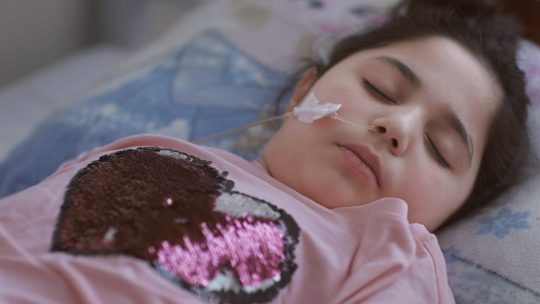


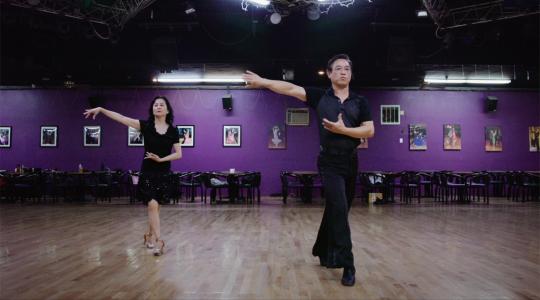

Best Documentary Short Film Nominees for the 92nd Academy Awards (2020, listed in order of appearance in the shorts package)
The Academy Awards may be finished, but I haven’t yet completed my annual tradition of reviewing all of the nominated short films for this year’s ceremony – this omnibus review will do the trick. Thankfully, the Oscars will revert back to their traditional last Sunday in February date next year (at least until 2022).
For the first time ever, I write an Oscar-nominated short film package review with a bias and – if you wish to phrase it – a conflict of interest. As a member of the Viet Film Fest 2019′s Curatorial Committee, I helped select Walk, Run, Cha-Cha for the film festival’s selection in early October. I am not at all affiliated with the production itself, but as a Viet Film Fest selection (a unanimous selection, mind you) I couldn’t help but feel proud of the film’s success.
Also, give these five films recognition for their fantastic titles.
Life Overtakes Me (2019, Sweden)
First identified in Sweden in the 1990s, Resignation Syndrome sees a psychologically traumatized child entering a catatonic state that could last for weeks, months, or years. It is considered a dissociative disorder that has only been affecting refugee children and adolescents who are going through an extended period of immigration limbo. Since Resignation Syndrome’s identification in Sweden, cases have been reported among refugee children who had been transferred from Australia – where asylum has been divisive to the nation’s politics for decades – to the now-defunct Nauru Regional Processing Centre (many refugees, hoping to be Australia-bound, are still on Nauru and statistics on how many children have Resignation Syndrome are not accessible) and in Greece. Life Overtakes Me, co-directed by Kristine Samuelson and John Haptas for Netflix, concentrates on the plight of Sweden-residing refugee children with Resignation Syndrome and their families. Many of these children in Sweden are from across Eastern Europe and the Middle East – some hail from as far as China’s Xinjiang province, home of the persecuted Uighur minority.
One doctor in the film describes the state of one child to her parents: “Your child is laying here like Snow White because everything is so terrible around her that this is a way of protection.” Life Overtakes Me, however, never adjusts its focus from explaining Resignation Syndrome. This is where it frustrates: neither the families nor their children are framed as being anything else than either the family of a child with Resignation Syndrome or a child with Resignation Syndrome. There is no discussion about the contemporary European migrant crisis, nor on the medical progress on understanding the complexities of the disorder and how to treat it. After depicting a child with Resignation Syndrome and another one, Live Overtakes Me has expended its see-it-to-believe-it aspects, becoming a tedious watch.
My rating: 6/10
Learning to Skateboard in a Warzone (If You’re a Girl) (2018, United Kingdom)
There have been a number of nominees (and winners) in this category in the last decade that sometimes feel like a shameless plug for a non-profit providing wonderful things for an underserved group abroad. Carol Dysinger’s Learning to Skateboard in a Warzone (If You’re a Girl), an A&E film, at times falls into that trap. The film documents Skateistan, a Kabul-based non-profit established in 2007 that administers a school for boys and girls (41% of the students are girls; the film will exclusively concentrate on the girls because of how contentious educating females was and is in Afghanistan), as well as the skate park attached to the school. In conjunction with their typical school subjects, skateboarding teaches the girls courage, resilience, and creativity. The film juxtaposes their beginners’ curiosity – examining closely their boards, playing with the wheels, not prepared to be balanced on a skateboard while rolling along without a teacher’s assistance – with their hardscrabble lives outside the school’s high (for safety reasons) walls.
Though these girls may not be competing in the Olympics (given that skateboarding is a new Olympic sport) anytime soon, the joy that skateboarding gives them is apparent. “I don’t want to grow up, so I can skate forever,” one girl says. If only. This is where Learning to Skateboard (If You’re a Girl) separates itself from the sports documentary/narrative film and becomes profound in a way I have not seen described by others who have seen the film. Similar to the fine and performing arts, sport is a medium of individual expressivity. An entry into ESPN’s 30 for 30 series can describe to a viewer the tactical dominance of the University of Miami’s (Florida) football team; I can also relate how the 2003-04 Arsenal (“The Invincibles”) played teams off the soccer field in becoming only the second team in English history to finish the top division’s season undefeated. But to those who are not engrossed in sport (or do not possess knowledge about the mechanics of a certain sport), it is difficult if not impossible to understand how those aforementioned teams played their games as a form of self-expression. By taking gender, a shade of politics, and Afghanistan’s history, it is easy for any viewer to see how – through skateboarding – these girls can express themselves in ways they could not anywhere else.
My rating: 8.5/10
In the Absence (2018, South Korea)
On the night before April 16, 2014, the Korean ferry ship MV Sewol departed Incheon for Jeju. The next morning, the ferry capsized and overturned. There were 172 survivors, but 301 passengers – mostly high school students who followed the captain’s orders to stay put, even as seawater started flooding the interior – and three crew members perished. The captain and other crew members disembarked during the rescue operation. Yi Seung-jun’s In the Absence documents, minute-by-minute, the actions of the disaster that sealed the fates of survivors and victims alike. Incorporating stock footage and Korean Coast Guard/government/civilian rescue diver recordings, Yi’s film portrays the desperation of the rescuers and the incompetence of those commanding them. The tragedy, from the moment that the crew recognized the danger of the situation, unfolds over several hours – enough time for a government response. Inexplicably, passengers were instructed to remain in place despite their inquires and the office of former South Korean President Park Geun-hye forbade all rescue boats from approaching the ferry until President Park herself gave orders.
Many of the documentaries – in short and feature-length – on the Sewol disaster follow the families of the deceased or the guilt among Coast Guard or civilian rescuers in not saving the victims in time. There are elements of both within In the Absence. Where Yi’s film diverges from those previous entries, however, is in its chronological precision in its first half and how seamlessly it transitions between the personal and the political (the film posits that the Sewol disaster response was a contributing factor to President Park’s removal, even though Park’s impeachment and eventual conviction had nothing to do, ostensibly, about the disaster) in the second half. From the committee hearings investigating the particulars of the government’s disaster response to the night of President Park’s removal from office, In the Absence packs an emotional wallop few documentaries of any length could achieve. One can see, etched in the faces of the victims’ parents, profound relief that someone is being held accountable for the disaster. That relief, though, is forever entangled with the fact that their loved ones are lost to the deep.
My rating: 9.5/10
NOTE: In the Absence can be viewed on YouTube as of this review’s publication.
Walk, Run, Cha-Cha (2019)
Chipaul (or just “Paul”) and Millie Cao were childhood friends in Vietnam (of Hoa descent) in the midst of wartime. During their childhood, they were enamored with American rock-and-roll and other popular music from the West – says Millie: “I love Bee Gees. And I can sing all Carpenters song [sic].” Chipaul’s family, who ran a business, saw the necessity to flee the country because of the Communist Party of Vietnam’s hardline attitudes towards political opponents – the Communist Party’s sins are too many to mention. Laura Nix’s Walk, Run, Cha-Cha, distributed by The New York Times, does not concentrate on war nor the fact that Chipaul and Millie, now married and living in Southern California after finding each other again (figuratively) through dance classes, are among the millions of Vietnamese-Americans – a community of refugees and their children and grandchildren – who have overcome cultural and linguistic barriers to make the United States their home. First and foremost, Walk, Run, Cha-Cha is a love story partially told through their passion for dancing. The film never loses sight of that.
Because this is a love story, there are those who might claim that Walk, Run, Cha-Cha is too slight a documentary short film to be taken seriously. That erases the fact the fact that when Vietnamese-American people or fictional characters are portrayed in Western cinema, they tend to be defined by a short list of tropes: the war-weary victim of war, an ineffectual gangster, or a nerd (this lumps in Southeast Asians with those of East Asian descent). Here, Chipaul and Millie are not defined by their pasts. Their dancing is not some act of overseas rebellion against the current government of Vietnam. Their family get-togethers do not ruminate over how difficult it was to sponsor Millie to become a permanent resident to the United States, but instead contain lighthearted conversations about the music they grew up listening and singing – endearingly a bit off-key – along to. Beyond the film’s requisite interviews, we see them in personal and recreational settings. Though perhaps not the strongest of the year’s nominated documentary shorts, Walk, Run, Cha-Cha flows the most poetically. Its final scene is perfection.
My rating: 8/10
NOTE: Walk, Run, Cha-Cha can be viewed on YouTube as of this review’s publication.
St. Louis Superman (2019)
Bruce Franks Jr. has spent his entire life in the greater St. Louis area. He has experienced firsthand incidents of gun violence (in general) and, following the death of Michael Brown at the hands of a police officer in Ferguson, Missouri. Brown’s death ignited a series of protests in Ferguson and brought to prominence the Black Lives Matter (BLM) movement – formed to call attention to systemic racism (and especially police brutality and racial profiling) against black Americans. In a sort of Mr. Smith Goes to Washington (1939) for this certain context, Franks becomes a community activist in the wake of Brown’s death and is soon elected to the Missouri House of Representatives in 2016. This MTV-produced film directed by Sami Khan and Smriti Mundhra is St. Louis Superman is a tad conventional in its biographical approach. The demands of being a state legislator and a family man are a curious balance to strike, and Franks is obviously not fully prepared – who would be? – to manage the expectations of his newfound role as public servant, father, and community leader.
It is fascinating that St. Louis Superman elects not to dive too deeply into politics, that Franks, a Democrat, highlights gun violence in its totality rather than police brutality towards black residents. Perhaps this is a political calculation, noting that Missouri’s legislature is majority Republican as is its current Governor. The film handles the personal adjustments made between Franks’ legislative career and his personal life, but whiffs – with the exception of the rap battle against a rival candidate for his seat – on juxtaposing how being a legislator invariably affects the nature of his community activism. Where St. Louis Superman succeeds is in its respectful portrayal of Franks as a man still nursing the wounds of having witness his nine-year-old older brother’s shooting death, and how this has driven him to where he is now. Franks, citing his mental health’s deterioration after the deaths of his godson and best friend in 2018, resigned from the Missouri House of Representatives in 2019. His career is a microcosm of the political struggles of African-Americans appealing to the decency of a seemingly unreceptive numerical majority, waiting and pressing the case of equal treatment in the eyes of the law.
My rating: 7/10
^ Based on my personal imdb rating. Half-points are always rounded down. My interpretation of that ratings system can be found here.
From previous years: 88th Academy Awards (2016), 89th (2017), 90th (2018), and 91st (2019).
#Live Overtakes Me#Learning to Skateboard in a Warzone#In the Absence#Walk Run Cha Cha#St. Louis Superman#Kristine Samuelson#John Haptas#Carol Dysinger#Yi Seung jun#Laura Nix#Sami Khan#Smriti Mundhra#92nd Academy Awards#Oscars#31 Days of Oscar#My Movie Odyssey
1 note
·
View note
Text
Naruto Episode 11 & 12 Review
Got PTSD? Just walk it off, you baby.
Review of Naruto Episode 11 and 12: The Land Where a Hero Once Lived and Battle on the Bridge! Zabuza Returns!
ArachCobra
So in this one, we start out with having Sakura guard Tazuna on the bridge, all alone. I'm just like, what? Apparently, it's because Kakashi is still not feeling well and Naruto and Sasuske are still struggling with the tree climbing things. So they do try to explain it. But the problem here is that there is no fucking way Kakashi can know when Zabuza will be back. Yeah, he can make an estimate based on the guy's injuries, but he doesn't know if Zabuza has some super healing ninja in his employ. For all he knows, Zabuza is heading for the bridge at a speed of mach fuck you right that very instant.
He isn't and Sakura is not gruesomely cut into confetti, but that's just because Zabuza has no easy way to recover. But this is still very risky.
Also, Tazuna calls Sakura lazy for yawning, which I feel is entirely uncalled for. Some guy named Giichi feels working on the bridge is getting too risky, so he quits, with Tazuna yelling at him.
Later, Sakura and Tazuna goes shopping and we get to see just how badly Gato has ruined the Land of Waves. It's an admittedly effective scene.
This is then ruined by the dinner scene where Sasuke and Naruto are shoveling down food so fast they have to puke. Hey, assholes, people are starving right now. Least you could do is respect the food you're given by not choking on it, just because you have to prove you're better than each other. Seriously, this is not team work. Time and time again we see this competition between Naruto and Sasuke makes them take quite frankly idiotic decisions that are detrimental for the team as a whole. Kakashi should get his act together and tell the two of them to get their shit together.
And then Sakura stares at a slightly damaged photo on the wall and Odysseus, the dialogue. To paraphrase Sakura: “There's a picture here. But it's torn. How did it get torn? It seems very important. The one who tore it must have had some sort of reason. I wonder why.” Honestly, most likely explanation is that Kakashi noticed the plot point hanging on the wall and asked Sakura to point it out until someone would say something and move the story along.
So then we get the tale of Kaiza. About how he saved Inari from drowning thanks to a trio of child bullies straight out of a Stephen King story. About how he saved the village when the floodgate broke. It's an interesting story, but made kinda silly by being punctuated by so much overly dramatic music and flowery language about how Kaiza: “Taught people the meaning of the word courage.”
And then Gato has Kaiza tortured by a group of goons before publicly executing him.
How... How can he do that? Is there no government in the Land of Waves? How did he get so powerful that he can execute people? In front of a large crowd of people even. In front of the guy's family. Did he buy out the government? How does that work? I mean, have him killed, yeah, that I can imagine, but publicly executing him for disturbing the order of the land? Kinda ridiculous.
And that's why Inari doesn't believe in heroes. Naruto goes out to train because he wants to show Inari that heroes do exists.
Neat.
For the next episode, let me just start by complaining about the title. It's called Zabuza Returns and Battle on the Bridge, but that's a fabrication at best. Zabuza and Haku show up at the very end of the episode and there is no battle on the titular bridge. Its just misleading.
Anyway, Haku crossdresses and meets Naruto in the forest and they exchange some awkward dialogue about having someone important. And that only by having someone important will you be strong. I guess that really depends on one's definition of strength, so I'm not gonna harp on that too much.
Anyway, tree climbing continues and Sasuke and Naruto returns, sweating, panting and covered in dirt. If you told me that's because they decided to celebrate with a victory quickie in the bushes, I'd believe you. These two really do come off as if they have some closeted feelings for each other.
Anyway, Inari says its all futile and Naruto calls him a coward and a crybaby.
Yeah, doesn't matter that the kid is traumatized by the death of his father and the decline of his country, while constantly having to worry that any day now, his grandfather will be slaughtered. Doesn't matter that this constant oppressive atmosphere of fear and futility has made him a nervous wreck with PTSD. Just get over it, kid. Anything else is cowardice.
In case it isn't obvious, I find this scene kinda sickening and insensitive.
Now, Kakashi says that Naruto didn't say anything he hadn't already told himself and that Naruto has suffered too. Well, great. Two problems. One, Naruto has not gone through the exact same scenario as Inari and even if he had, he'd probably have reacted differently, because people are different. He has no right to demand that Inari ”gets over it.” Second issue, from a narrative point, how bad did Naruto have it? We have some general ideas that he was excluded and people looked down on him, but it hasn't really been elaborated upon. We're just told Naruto has it bad and that's it. So here, the story trips over itself trying to justify Naruto yelling at a traumatized kid who's not even had a chance to properly grieve and get over the soul-shattering losses he's experienced.
To put it mildly, it doesn't really work. No matter how much the show insists that Naruto understands Inari's pain.
Anyway, next day, Zabuza shows up, Naruto is late and Gato's henchmen are getting ready to kidnap Tsunami and Inari. Oh, who's Tsunami? Inari's mother. She's been around for three episodes, but does very little. I think we only learned her name this very last episode in fact.
Shame. You'd think somebody with the name Tsunami would be a character you should keep an eye on.
Anyway, first episode works just fine. Second one dragged down by Naruto's treatment of Inari. Seriously, that's not okay.
Givenea
Inari, grandson of Tazuna takes over the role as awesomest character, for telling Naruto how dumb he is.
We then learn that Inari has lost all hope because a business tycoon turned his homeland into a dictatorship, everyone is starving and poor and his stepfather (who was the most amazing dad ever) was executed by said tycoon for trying to make things better.
Then Naruto calls him whiny.
Yup, Inari, an eight-year-old, who has lost his freedom and security and is struggling to cope with the loss of the only father he ever knew, is whiny. And Naruto is the right character to set him straight, because… a few people sneered at him…?
That’s all we’ve seen… Let me elaborate.
Back in episode 1, the big bad, Mizuki informs Naruto (and the audience) that Naruto is shunned and hated by the villagers because he is the container of the nine tailed fox. But this doesn’t stand up to scrutiny.
Within the first episode we see Naruto be chased down by ninjas, sneered at by his classmates and some random women and conned by Mizuki into stealing secret information.
This is not bad; it sets up that there is bad blood in between at least some villagers and Naruto. Next step would be to reinforce this idea over the next few episodes while establishing a norm for Naruto’s day to day life in Konoha. Naruto does runs into trouble with villagers a bunch of times within the first two episodes but only once or twice is their scorn unprovoked on his part. Going over them in order:
Episode 1:
Chased by ninja: He committed vandalism and skipped school. - Was punished by having to clean up his mess.
Sneered at by classmates - Because he mouthed off, they all had to redo a test.
Sneered by random women – Apparently unprovoked. Could be viewed to refer to the fox
Conned by Mizuki – Because he had the fox, Mizuki figured he could get away with it, taking advantage of him while he was vulnerable.
Episode2
Scolded by the Hokage – Naruto screwed up his ID and mouthed off.
Beaten by random woman – She was angry over Konohamaru’s botched transformation, unprovoked, but also nothing to do with the fox.
Thrown out of bookstore – Clerk did not allow reading before buying, had every right to toss them out.
Beaten by women in the bath - After attempting to sneak in and peep on them. They also immediately recognize, not only that Naruto and Konohamaru are transformed, but one also cries out: “Naruto, you again?”. Giving the distinct impression that this is a common occurrence.
Fight with Ebisu – while Ebisu does refer to Naruto as a fox, he seems far more miffed at Naruto taking Konohamaru all over town and distracting him from his training.
Ok, two things
Most people do not seem to care about the fox, whatsoever. They are instead reacting to Naruto’s actions, which are annoying at best and criminal at worst.
Nobody really seems to hate Naruto enough to step in and stop him from hanging out with the Hokage’s grandson. If Naruto was really shunned to the point we are supposed to believe, wouldn’t they try to save Konohamaru from the monster they believe the blond brat to be?
So while some people have treated Naruto pretty harshly, the whole thing fails in setting him up as an outcast through no doing of his own. It also fails at putting him through anything even remotely as bad as what Inari has suffered. So, when Kakashi later try to smooth things over, and encourage Inari, by explaining Naruto’s hardships and saying he got tired of whining and decided to do something about it, it falls flat.
Not only that, but when did Naruto ever stop whining? He pouts like a child whenever he doesn’t get his way.
Moving along.
After learning the tree-lesson instantly, last episode, Sakura is put on guard duty… well, it needs to be done, but couldn’t Kakashi have given her some other training since she’s ahead of the curve here? Not to mention, what is she gonna do if Zabuza or one of his people shows up? She is one lone genin, who has barely started her training as such. He, even wounded, is a highly trained jonin and we know that he has at least Haku to help him out.
Could be that this is just Kakashi’s way of paying lip service to doing this job.
So, Tazuna calls her lazy… I haven’t the foggiest why. After having lied to her superiors and then guilted her team into staying on a mission they are in no way qualified for, he should understand that just showing up is going above and beyond what anyone could expect from them.
So I guess these episodes are just here to make everyone look bad.
Oh yeah, and then Zabuza and Haku shows up.
Fluttersniper13
Sasuke and Naruto are having a dick measuring competition, Sakura is useless, family issues all over the place, Gato is god and everything is miserable. So, the usual shit.
Link: https://www.fanfiction.net/s/13125294/8/Naruto-Rewrite-1-Road-to-Ninja
1 note
·
View note
Link
Our hero committed sexual assault.
There’s no getting around this fact. It happened. We watched it happen. Sydney explicitly says it in the final minutes of the episode: “You drugged me and had sex with me.” It feels important to say it up front, before anything else. I must have started and re-started this review a half-dozen times, and there’s no other way to address David’s act without seeming to minimize the impact of what took place. There are ways the show can deal with this next season, and there are stories that can be told, but as it turns out, it wasn’t just a comic-book conceit to have the characters imply David might be the villain of this story. David is the villain. And to quote Syd, maybe he always was.
This is upsetting, disturbing stuff, and for the first time since I began watching this weird and often wonderful show, I’m not convinced Legion is capable of telling the story it just waded into. To understand why is to pull at the messy threads of narrative convention. I spoke at length in last week’s review about what has made this such a polarizing season of television. Legion has been shedding viewers, and I think it has a lot to do with the willfully alienating nature of the story. It became positively Brechtian in its refusal to allow the audience a point of identification, or a way to trust the show. Not just in the sense that we couldn’t necessarily trust our own eyes—we’ve known from the start that reality is malleable when it comes to the powers of David Haller and the Shadow King—but in not providing us with protagonists in whom we can believe. We can’t trust David, we can’t really trust anyone, not with delusion creatures roaming free.
Legion stripped away our ability to look to its characters for reassurance, which is a foundational building block of humanism and empathy. One of the reasons the Loudermilks have become so appealing this season is because their guilelessness makes them some of the only people that convey a sense of reliability. I can believe in them—or at least, the show hasn’t given me much reason to actively not believe in them, which is something I can no longer say with much confidence about any other character, really.
A second issue is about the implicit contract between audience and show. When we’re given a protagonist, we plan to follow them on their journey, and we have certain expectations that accompany such a journey, for good or ill. A key expectation is that we will be given entry into a character’s point of view. We need to know who a person is, and if we’re given that, we can follow them anywhere. Good guys like Leslie Knope, antiheroes like Tony Soprano, grouchy bastards like Gregory House, even good-to-bad characters like Walter White—they can lie, cheat, steal, hell, even poison a child in Walter’s case, and as long as we know their motivations, their point of view, and the perspective of those around them, we can go on that journey. We don’t need our characters to be heroes.
But this is Legion, a Marvel superhero show. What has made it consistently fascinating is the way that Noah Hawley and his creative team have repeatedly pushed back against those expectations, not caring that it would alienate people looking for a certain familiar structure in their TV series. Yet when it comes to character, there might be certain rules that work better unbroken. Removing our ability to relate to characters, and stripping away the humanism that undergirds our identification with the people whose lives we’re watching unfold, is a fundamentally avant-garde move, because it severs the basic premise of narrative drama: Namely, that we can understand who this person is and why they do what they do.
If you’re halfway through watching Out Of Africa, you know you’re not going to have a sudden smash cut to a pornographic, throbbing sex scene between Robert Redford, Meryl Streep, and another person, because that would violate a basic understanding of the world that’s been established, what a mainstream movie provides, and also how these characters would behave. Similarly, Legion has established that there are many facets to David, but despite the depictions of a malevolent David, or a homeless crazy David, or even the fears of our primary David about the violence he’s capable of inflicting (something that wasn’t even introduced until the last couple of episodes), we had been given a fundamentally good person. Naive, even, in his sincere belief in true love, admirable in his loyalty to his friends, and—above all—steadfast in his refusal to accept evil or unhappiness as the outcome. When Syd brooded over their likely unhappy ending, David was the one to say he believed in a better one. Even when he was torturing Oliver last week, we may not have liked it, but we understood doing something bad to achieve something good. He was trying to save Syd.
Transforming David from a fundamentally decent person with a troubled mind into someone capable of committing sexual assault in the course of a single episode is the needle scratch on the record player. It’s the porn scene in the middle of Out Of Africa. It’s edgy and unpredictable, but that doesn’t make it good. It changes the show on a fundamental level—and more than that, it pulls the rug out from under its viewers, scorning them for thinking they were watching one kind of show when in fact they were watching a very different one. It’s one thing to have a show’s characters lie to us. It’s quite another when a show lies to its audience.
There’s an argument to be made that these kinds of stories should be told. From the perspective of a show looking to tell difficult tales about difficult people, the decision to have David do this to Syd probably felt like an all-too-accurate and believable version of how these events play out in everyday life, albeit aided by psychic powers instead of roofies. But I’m not sure a show where guys with baskets on their heads and kung-fu fight scenes set to Jane’s Addiction has earned that story beat. When someone on a Marvel superhero show—even one as odd as Legion—tells us a character might become a villain, we allow for powers, and betrayal, and even violence. But abruptly pivoting to a painful and common reality feels like a betrayal of the narrative contract the series spent two seasons establishing. Farouk is a rapist—he is the villain and has been clearly established as such, so we accept it. I don’t know if I can accept David’s actions, not when they haven’t been properly set up narratively and justified psychologically, both on our end and his.
David defeats the Shadow King (thanks to Lenny’s bullet and the Choke) and starts pounding him senseless, but before he can land a fatal blow, Syd shows up and tries to shoot him, having been convinced by Farouk-Melanie that her beau was indeed becoming a monster who must be stopped. It’s understandable David would feel betrayed; he had just done a bunch of ugly stuff, all in the name of protecting his love. (“It’s what we have to save,” he again echoed in his words to Oliver.) And he’s not that person—not yet, anyway. It’s actually very easy to feel for David in that moment, as he’s so hurt: “Don’t you trust me?”
So when he wakes up in his own basement, and proceeds to have the three-way argument with himself, you can see why these new versions of David have erupted. He’s wounded, and the one person he truly loved has somehow rejected him in the most clear-cut manner imaginable, so a part of him tries to make sense of it in any way he can. Hence the disagreement—she’s his parasite, her love is the delusion, they all owe David everything and he should just take charge as a superior being. The episode continually returns to the God metaphor, from his quick aside to Lenny (“God has plans for you”) to Clark’s season-ending words: “Now we pray.”
Even Farouk is sounding like the voice of reason in that regard. David’s late night debate with his tormentor hinged on the Shadow King making David see how his actions weren’t all that different from Farouk’s. The moment that Farouk makes David realize how his efforts will backfire—and we learn just what David did to Syd—is a brutal one. The decision to suppress her memories is indeed a form of drugging her—he’s altering her perception to get what he wants, and once Farouk is safely contained, and Syd’s in her room, he projects himself in there, tells her everything’s fine, and proceeds to sleep with her. It’s vile stuff—there’s a reason that when Buffy The Vampire Slayer pulled a lesser but quite similar move, it made sure to have the victim discover she’d been magically drugged before any intimacy happened. Because that’s a line that can’t really be walked back, character-wise.
And part of the problem is that the show itself doesn’t seem to understand the severity of that breach. “The Trial Of The Shadow King,” with its text-based reflections on the nature of truth, muses that perhaps the competing realities of the situation should give us pause. That perhaps everyone has been swayed by the Shadow King’s machinations, which is why poor David has been found crazy and in need of either medicated imprisonment or death. And hey, that would’ve been a great place to end the season—with a knotty ambiguous debate over reality itself. But Syd’s statement of what David has done isn’t something you can muck about with, hemming and hawing over whether reality is being distorted. And it’s a disservice to the intensity of that choice—and the legitimacy of Syd’s assault—to fold it into the show’s usual “who can say what truth is?” philosophizing.
And maybe that’s the big problem with the second-season finale of Legion: Certain acts don’t get to be up for debate, and it’s a cheat on the show’s part to think sexual assault can just be part of the furniture. When nothing can be spared from getting walked back, when we are potentially being lied to about everything, then our sense of investment, our stakes in this world, go out the window. Acts need to have meaning, not be idly ruminated on with quotes from Plato. Does Legion really think there are competing truths about what David did, regardless of whether the Shadow King has everyone in his thrall? If so, then the closing words of the Tori Amos cover that ends the season are apt in more ways than one: “This is not real / This is not really happening, hey.” It’s not until the credits roll that the next line arrives—“You bet your life it is.”
Stray observations
Legion significant music cues of the week: They all pretty much pale compared to that opening version of The Who’s “Behind Blue Eyes” that David and Farouk are singing, with its spot-on lyrics. (“No one knows what it’s like to be the bad man, to be the sad man...my love is vengeance.”) But the others are the aforementioned show-closing cover of “Cornflake Girl” (if you want a great rock cover of that one, here it is), and when David’s in his own room, about to go back on the plan the other Davids apparently concocted, a similarly dark cover of The Kinks’ “Nothing In This World” is playing.
“I’m a good person. I deserve love.” This would’ve landed so much harder if David hadn’t just done what he did.
I don’t think it’s a coincidence that the Loudermilks have been our most reliable source of identification and Cary is the one who discovers what David did to Syd.
When the mouse first showed up in Farouk’s cell, was anyone else thinking it was going to start singing Bryan Ferry?
Oliver and Melanie’s flash-forward, with them living in the ice cube three years after the events of this episode, was a rare and much-valued moment of levity.
“You really believe that? God loves sinners best?” Methinks we’re going to find out. Dan Stevens’ performance this year has been stellar.
Thanks, everyone, for watching and reading. I’ve enjoyed hearing all the theories and discussions of this very unusual season of television. Sorry it had to end on a down note—I can certainly say I’ll be curious to see where Legion tries to go from here.
#(um...yeah I'm kinda dealing with this too tbh; kept saying He should ask her if she wants it he should ask her...)#Legion Season 2 Review#Spoilers#AV Club
1 note
·
View note
Text
Death Note (2017) and the Comparative Lens
I’ll be honest. When I found out that Death Note was getting an Americanized live action adaptation, I wasn’t too thrilled. In fact, I was terrified that something I loved was going to be straight up murdered before my eyes — and I wasn’t ready to give it a shot. In fact, I was really unwilling to budge on this until recently.
However, about three hours ago, the movie came out on Netflix. Sitting there with my housemates, I decided to give the movie a shot and check it out. for those of you who would like to avoid spoilers, this is the cutoff point for spoilers. There are an awful lot of them beyond this point.

Death Note is not a particularly new thing to many of us. If you’ve spent an hour talking about anime or reading manga, you know that Death Note exists. Finding out about the series or the source material that preceded this movie is not particularly hard; the hard part comes in discarding the source material to give the movie a fair shake.
When you look at something like this, you have to discard your comparative lens at the start of the movie to suspend your disbelief. When you sit down to watch something like, say, Game of Thrones, you are undertaking that viewing with the understanding that it’s not going to be exactly like it was in A Song of Ice and Fire.
The same thing must be done for Death Note (2017). When you sit down to watch this movie, you have to decide if you want to give it a fair shake. If not, that’s fine, but that’s what I set out to do.
Starting from the top, the movie itself isn’t bad. If you hadn’t seen the anime before watching it, it holds up to a 6/10 or a 7/10, but likely doesn’t pass an 8 on most scales. Let me explain by starting with some discussion on the main cast before getting into the actual synopsis and response.
The casting of Lakeith Stanfield as L is great, and he dramatically outperforms the rest of the cast; his take on L is both familiar to those who want similarities to what they know and slightly more emotive and human to appeal to the audience. His grasp of the character is magnificent, and I’m sure he studied for this role. I’d highly recommend watching this movie just to watch his performance if nothing else.
There’s only one problem with this: his performance feels slightly hollow when put next to Nat Wolff and Willem Dafoe. Willem Dafoe is a great man and a talented actor… but this is by no means his best showing.
Nat Wolff, comparatively fresh to the silver screen (or technically not, since it’s closer to a direct to DVD release), paints a picture of a very fragmented Light. At times too comedic, too frustrated, and too unbelievable, his portrayal of his character comes across as transparent. It surprised me to find that his version of Light didn’t hold up to the “judge and jury” that the film tries to make him.
Light is at times frustrating and all said, a little annoying. My favorite moment of his in the film comes three minutes in, when a bully punches him in the face and knocks him out.
The funny thing about the casting, though, is that it gives Margaret Qualley, playing Mia Sutton (analogous to Misa, from the series) the chance to shine in a dark way.
Since we’ve now discussed the cast, it’s important to note that the casting for this movie is not to blame or to praise in its success or failure. Whether or not this movie is good does not depend entirely on the choices made in its casting.
The movie itself revolves around Light Turner (an Americanization of Light Yagami), the son of a “hippy” and a police chief. Light, after passing off some homework for money to one of his fellow students, finds the eponymous Death Note when it falls from the sky in the middle of a storm. Light, after meeting Ryuk, is forced to come to terms with the power he now holds… and the consequences that accompany that power.
One of his first confidantes is his fellow student, Mia Sutton; Mia is initially skeptical, but after Light kills a criminal on a live stream, she comes around to his side and the two quickly enter into a strange love affair based on his ability to kill these criminals. Light takes the name “Kira” in order to make law enforcement suspect that he’s actually based in Japan, as “Kira” is a true cognate for the English word “killer.”
Hot on Kira’s heels are his father, who doesn’t know his son is involved, and L, a young detective with a murky past. L quickly deduces that Light is based in Seattle based on the mysterious circumstances surrounding the death of a hostage taker, whose name was only released in the Seattle area.
Correctly linking Kira to Light’s father, L begins the investigation in earnest, accidentally pushing the inexperienced boy and his new powers too far. After quick, dazzling victories over the danger known as Kira, L confronts Light in a coffee shop one night, convinced of his foe’s identity.
It’s at this point that things take a sharp turn. Light, in the films, is just a schoolboy in over his head, eager to impress his girlfriend with his “wicked cool” murder powers. He is not the character most loved in the manga or the anime, and this is why the adaptation must be viewed differently. Light’s identity is discovered after the death of several task force members and the public revelation of his father’s name and face on TV. Unbeknownst to Light, Mia murdered those men with a page from the note, attributing it to Ryuk.
When Mr. Turner isn’t killed, L confronts Light in a cafe at night, revealing to him that he’s aware of the high schooler’s alter ego. After Light tries to explain that he didn’t kill the task force members, his pleas fall on deaf ears, and L tersely informs him that he’ll be brought to justice.
After this, things take a steep, steep increase in pace. Light and Mia manage to take control over Watari using the Death Note, with the rule in place (via the notebook) that a person can be controlled for two days before their death. Light, in order to circumvent Watari’s death, intends to burn the page containing Watari’s name before he dies, sparing him.
Unbeknownst to him, Mia takes the page from his notebook… throwing a spanner in the works.
After the death of Watari, Mia reveals that she’s been planning to take the Death Note for herself. Light is then forced to flee by a vengeance driven L, given the ultimatum that if she doesn’t get the notebook by midnight, that he will die (as she’s written his name on her page).
L catches up to Light in the back of an alley as Light tries to meet Mia at the spot of their last date to hand over the notebook. He tries to explain what happened, but L doesn’t listen… and despite having Light at gunpoint, is knocked out from behind by a nearby citizen who overheard Light admit to being Kira. Grateful for what Kira has done, he lets Light go.
Light makes it to Mia atop a ferris wheel at the pier… and tells her not to take the book, as he’s written her name in it, putting them at a stalemate. Only one page of the book can be burned by its holder (Light), and unbeknownst to Mia, Light has made her death conditional. If she takes the book, she will die.
She takes the book and dies.
Light, having written his plan out in advance before fleeing L earlier, is saved when he falls into the water below the pier and is rescued by an old man, whose name he wrote in the book earlier. At the same time, another old man (both criminals) takes the Death Note for two days while Light recovers, filling out pages for him to give him an alibi.
This is explained to Light’s father while Light recovers in the hospital. The movie comes to an end as L realizes the meaning of a clue Light left him during the movie’s main chase scene; finding a stray page of the Death Note, L contemplates writing Light’s name… and Ryuk comments on the interesting nature of mankind.
Back to the review, though. The narrative pacing of the movie is rushed in the front half, for obvious reasons. The pacing that ensues around the climax of the movie, though, is great. The reveal that Mia is actually the antagonist of the movie makes sense and was well thought out. It’s not blatant, but it is foreseeable if you pay attention to her character throughout.
The cinematography is… amateur. It’s not very refined, and most shots make up for in color what they lack in substance. The camera work, for the most part, resembles a college student’s final short film.
Characters often abandon the rules established for them by their characterization in the first half of the movie in ways I’m unsure of. L turns into an action star in the last thirty minutes, and Light is… well, he’s annoying all the way through, but he never really gets a solid definition. The only way to sum up his character in the film is “inept,” but it does bring you to mentally treat him like a villain, which is good.
Its ending is vastly different from its source material (as L is alive), but ultimately more satisfying. The problems that plague the movie throughout, though, never really go away.
Despite this, most cast members put on a strong performance at least once in the film, and the movie follows a nice, neat arc. Reveals are carefully done and at multiple points, I was on the edge of my seat. Gorey action scenes (usually gratuitous deaths) aren’t cheap; they reinforce the notion that what Light is doing is wrong, even if he’s doing it for the right reasons. At no point do I sympathize with the character, which is a little frustrating, but also familiar.
The soundtrack… I don’t like it. It’s too “eighties” for me. It tries too hard to sound like Miami Vice, for unknown reasons. The music is too heavy handed, and often too easily applied to each scene. At no point am I left to wonder the nonexistent subtleties of its soundtrack.
This movie is a solid thriller, with a satisfying ending, a decent cast and a good narrative arc. Despite this, Death Note (2017) does not follow well with its source material, which it uses primarily as a guideline. If you’re expecting to see familiar faces from the manga (or even the anime), you will be disappointed.

Lakeith Stanfield kills it, though.
#death note#death note 2017#lakeith stanfield#nat wolff#light yagami#l#misa amane#deathnote#manga#anime#review#netflix
1K notes
·
View notes
Text
Research: Draw Draw Draw Project.
Mike Parr Mark making artist
Parr's performances explore physical limits, memory and subjectivity. They often depict self mutilation or extreme physical feats.
Parr spent his childhood in rural Queensland, Australia. He was born with a deformed arm, and this physical feature is prominent within his art work.
Parr’s impression taking is a striking contrast, both emotionally and visually to his video/ installation work, composed of beautiful engravings featuring many different types of lines, using the mark making technique. Parr was fascinated with observation and the possibilities and responses of memory distortions.
Parr’s early work was designed to get a reaction from the audience, although he also focused on exploring issues of identity, memory and states of being. He particularly used his body as a performative tool, often using his prosthetic arm and testing his body’s physical limits through resistance challenges.
In the early 1980s he started a collection called “the self portrait project”, Parr’s self portrait studies first took the form of painstakingly hand drawn copies of performance photographs. Subsequent drawings acknowledge accidental blurs and smudges, with parr generating purposeful distortions through the introduction of a mirror and manipulating the grid.
Life after death collection, combines charcoal, pastel and acrylic on paper; it depicts the artist’s face over and over, in varying states of distortion, as though disappearing or disintegrating.
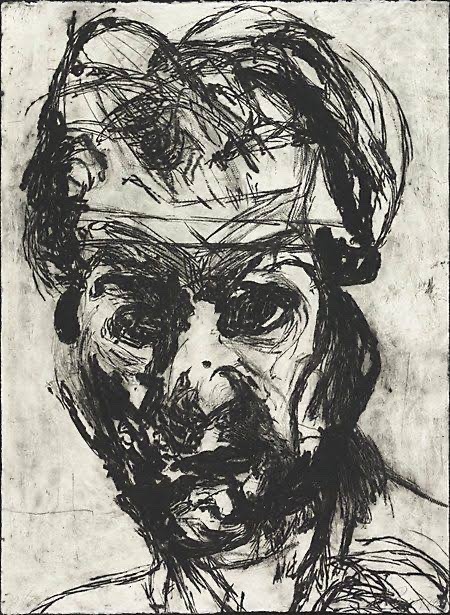
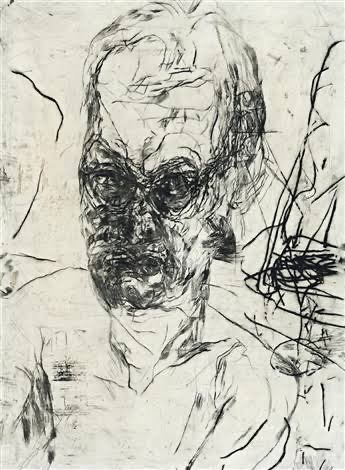
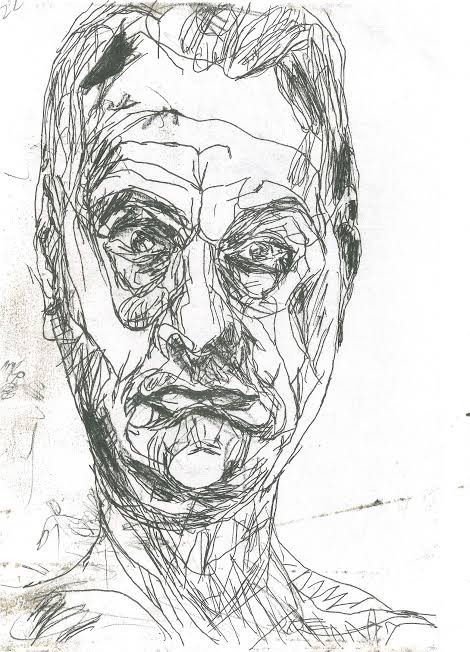
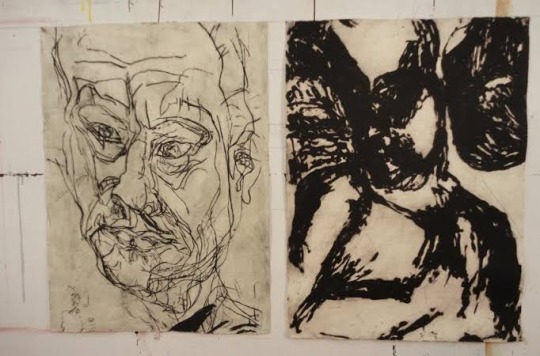
Paul Verdell
Is an American artist, who is specialized in drawing portraits of many different people that he can find as reference, by using different kinds of colors and lines with his crayons.
Verdell was born in Long Beach, California. At the age 13, his family moved to Fremont, Ohio.
Paul Verdell paints and draws a variety of people with plenty of personality. Like most artists, he has drawn since he was little, but didn’t make a real go of the medium until he was in his mid 20s. That he was decided to go back to school, enrolled in Bowling Green State university, and took a painting class when the first semester came around. Paul eventually developed his unique artistic style, by doing drawings, that him doesn’t consider that good, but he is comfortable with that style. His mark making technique is assertive, created with force and with energy. Paul’s work may seem as if it has loss control imbued within the lines, but his artworks are also vividly representative of the person or object he’s depicting; it’s delicate balance that he’s mastered without purposely pushing his style in a certain direction.
What I like most about his work, is his use of colors, with oil pastels , where he creates different tones on the skin of his characters, using the technique of mark making, which is perhaps more impressive, since it is a very different or unconventional technique for making portraits, that’s why it’s so interesting.
With time, he realized how much colour and expressiveness the textured medium adds to the canvas, and started to experimenting with more and more different types of colors.
The artist isn’t trying to make a statement with his work. In his words, “I’m just here to paint. The viewer can take whatever that want to take out of it”.
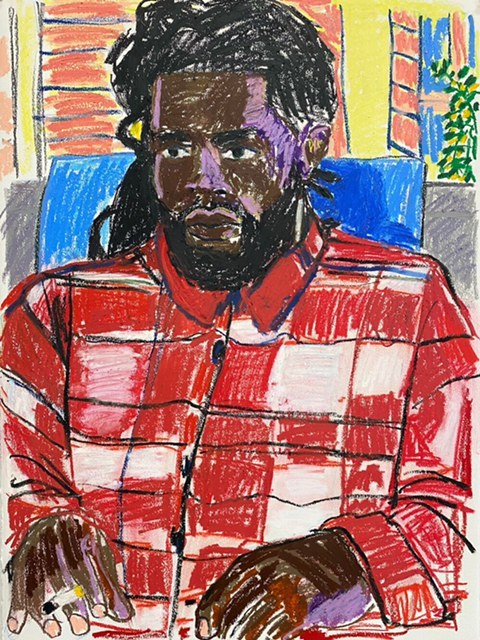
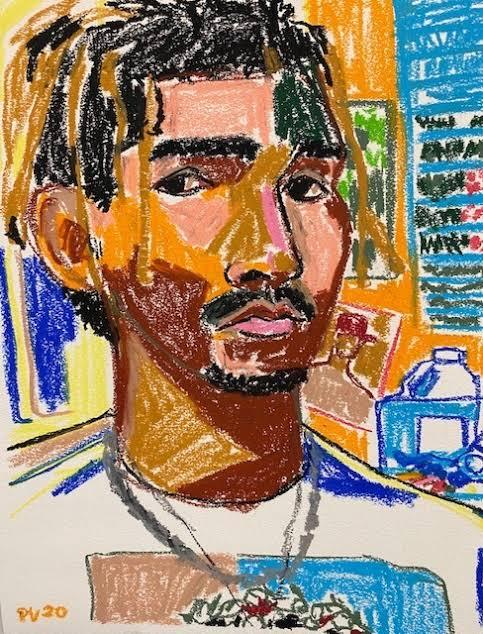
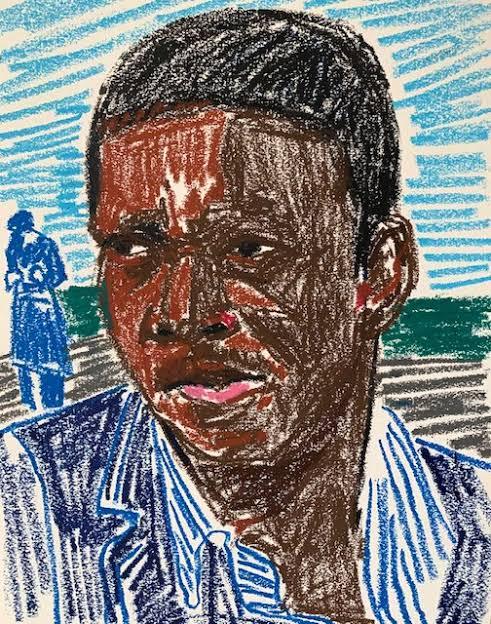
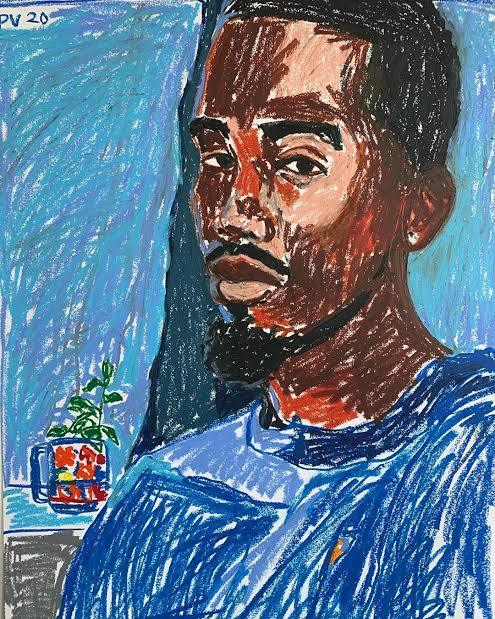
Saul Steinberg
Romanian artist by birth was one of the most important artists of 20th century. A designer and cartoonist in the publishing industry from 1936 to 1999, he spent a considerable part of the 20th century publishing in prominent magazines on the world stage, specially in the New York. The famous cover for the New Yorker that showed the view of the world according to the average American.
In his drawings, Steinberg’s lines seem to reinvent themselves as they progress, creating different kinds of shapes and sizes, sometimes using one single line.
Steinberg’s greatest contribution was his demonstration that the drawn lines is equivalent to thought. Indeed, Steinberg is rarely concerned with outward physical appearance and is much more interested in what and how people perceive what they see. His interest in the human psyche isn’t academic. His playful, childlike doodle quality maintains an elegant deftness that succinctly describes a wide range of subjects. His quirky way to draw, sometimes reminiscent of Dada art, also crossed over into the fine arts world.
much of the humor and mystery in his work occurs in the way he relates humanity’s lack of understanding.
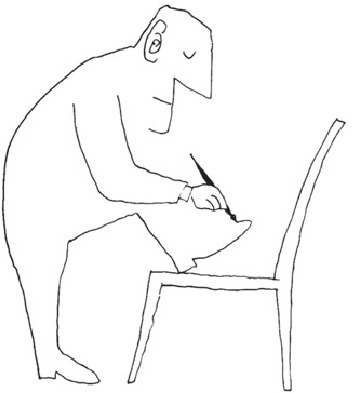
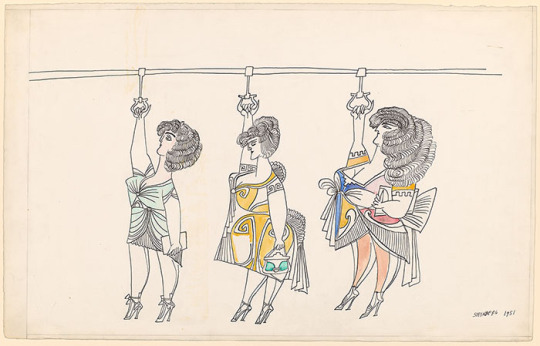
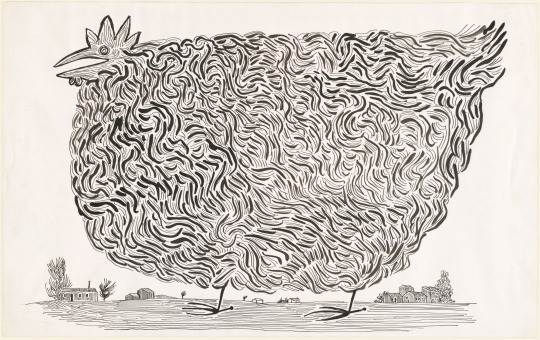
Urban Sketching
The drawings of urban spaces are gaining more and more admires, and this work certainly has a good baggage to please this audience, as it addresses a range of drawing techniques, which ranges from elementary theory to the more specific technique used by illustrators this modality.
Techniques and perspective tips combined with the composition tips presented in the work, are a combination that certainly makes all the difference when choosing and enhancing the scene that we will sketch, whether it be designing buildings, mansions, parks, people, animals, etc. the inclusion of the curved perspective is also another highlight, as it goes beyond the usual three vanishing points that the author usually address. The techniques, in this sense, are not many, but the author certainly selected those that generate the most impact. The watercolor for example, is his primarily tool, where he uses for the most of his drawings.
This book has been very useful for me for a long time, even today I use it as a reference. I always preferred to draw on my desk, with a reference photo. But I know that I need to let go, and learn to draw outside, just by watching, and trying to finish quickly.
I live in São Paulo for a while, and sometimes when I walk I always have a small sketchbook in my pocket and a watercolor kit. Sometimes I paint trees, sometimes buildings with interesting shapes and colors, from time to time some birds. Anyway, I learned a few things from this book, although I still prefer to draw in my studio, calm and do the drawing with all the time in the world, it is very important that I draw what is around me, so that I learn to train my eyes, in addition to drawing totally random things, which sometimes the internet cannot provide.

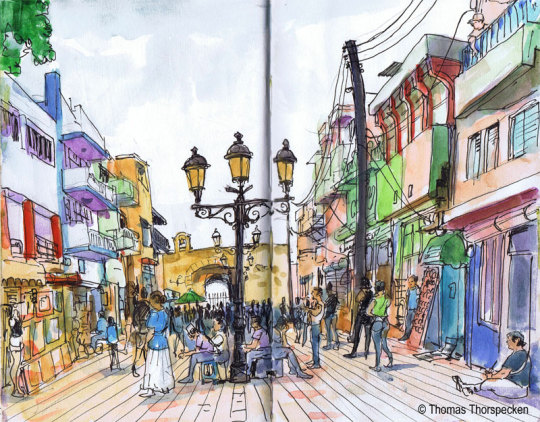
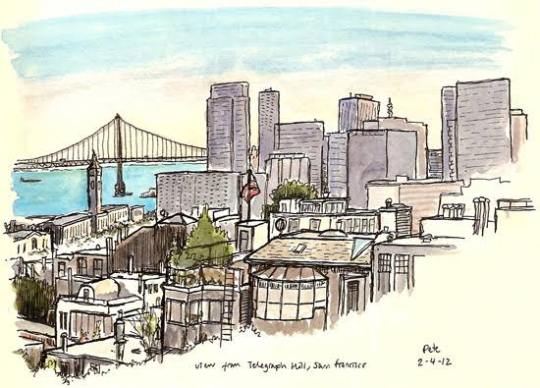
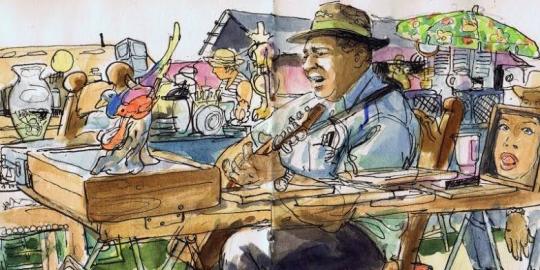
Alexander Calder Animal Sketching
Alexander Calder is a renowned sculptor and inventor of mobiles, and here he brings the simplicity of lines and spirit of movement to the art of animal sketching.
The purpose of the book is to help people like me to draw animals as we can see them.
Calder captures the emotions and attitudes of animals in a few quick lines, the person can quickly obtain a lasting groundwork in animal sketching.
This book really helped me, because I drew animal few times, and I was always thinking in the proportions and finalizing the drawing, but I learned that before doing that perfect drawing, I have to understand the movement and the poses, not necessarily making a masterpiece right in the begging, but train and have some fun on doing it.
This book contain several animal sketches, like cats, dogs, deers, cows, horses. All this animals doing different poses and actions for training.

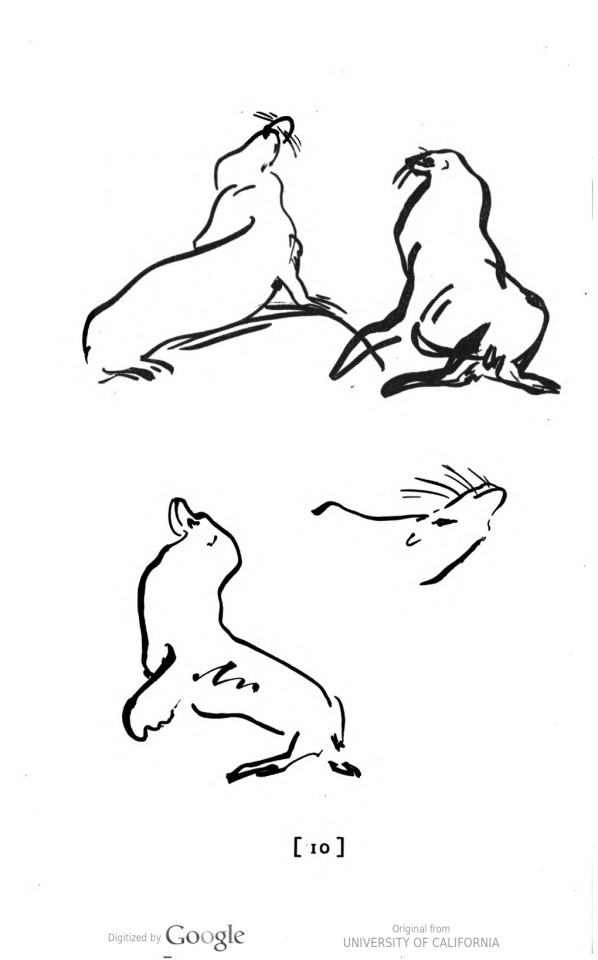
Juan Linares
Juan Linares is a Spanish illustrator and painter, who specializes in drawing mainly different environments (Urban sketching), from streets to buildings with a different style of architecture. He mainly understands the perspective and depth of the environment. Uses various types of materials, such as acrylic markers, even alcohol-based pens. But his preferred tool, of course, is watercolor, which he always uses, when walking in the streets of his city Barcelona, where he paints narrow streets, with the small bistros, from the famous La Sagrada Familia church made by Gaudi.
Linares says, that he’s been drawing professionally since 1984. Starting his architecture studies. He drew in sketchbooks, notebooks, and in blackboards. He has a preference in drawing food and buildings.
What I like about Linares's drawings, is the way he can put light and shadows, besides the buildings being magnificently well done, very carefully and calmly (he explains that if you are drawing in some environment it is good to be calm, and patience without feeling the need to finish quickly).
He has traveled to some places in the world, including Brazil itself, where he sketched the museum of Niterói, designed by the architect Oscar Niemeyer, besides the Christ the Redeemer in Rio de Janeiro.
Juan Linares is a great artist, and I really admire the passion he puts in each of his drawings. And I wish to see more of his works, of famous architectures of the world.

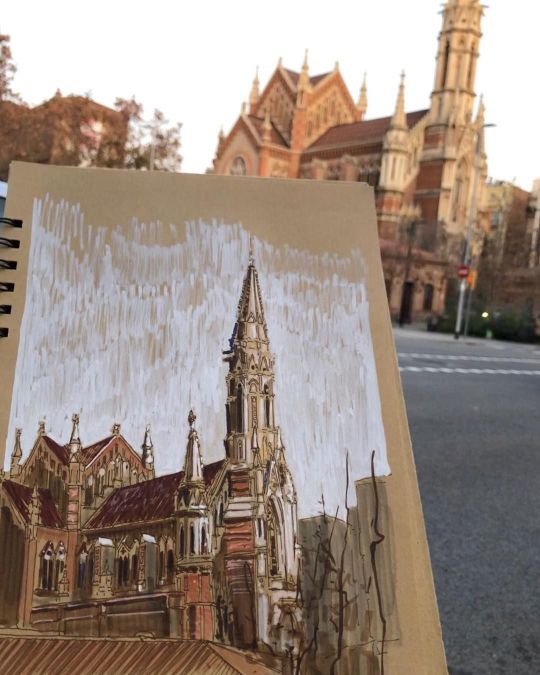
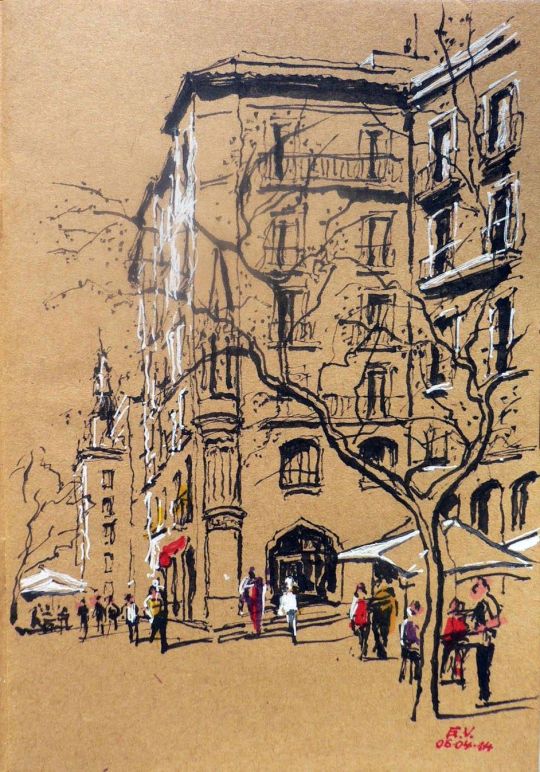
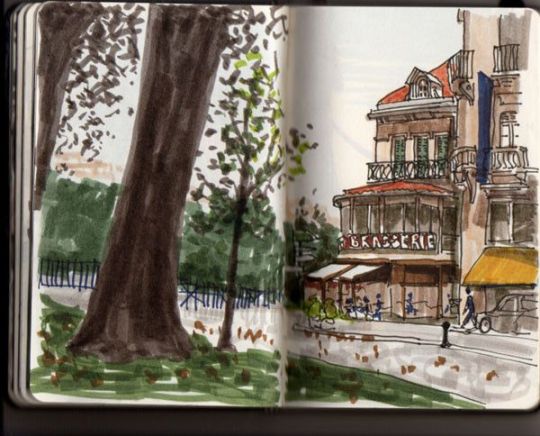

Laura Carlin
Laura Carlin was born is Glastonbury, England. She studied at Buckinghamshire university, followed by The Royal College of Art.
Laura has illustrated many children’s books for Walker Books Ltd, including The Iron Man by Ted Hughes which won many awards, specially praising for Laura’s illustrations.
She has also drawn for a whole host of publications including The New Yorker, The Guardian and Vogue, among many others.
Laura’s works frequently touches on emotionally complex subjects and adult themes of loss , social injustice and environmental change.
As an illustrator Carlin has worked with several contemporary children’s authors including Nicholas Davies for her book The Promise about a young thief whose life has changed after stealing a bag of acorns and Michael Morpurgo’s book The Kites are Flying ! , a story centered on the conflict between Israel and Palestine.
One of the reasons why, I like so much her work, it’s because she has the ability to convey a plethora of emotions through the smallest details on the pages, combining with childlike drawing style and with a sentimental narrative, it’s very brave of her, to do books for children, with such difficult themes to explore.
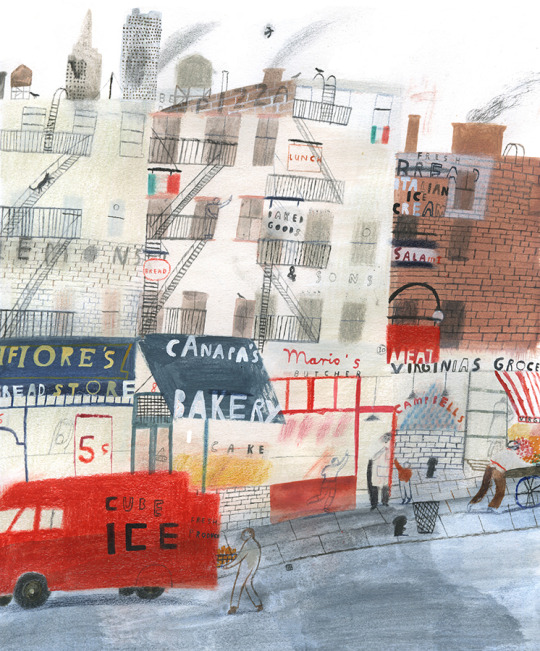
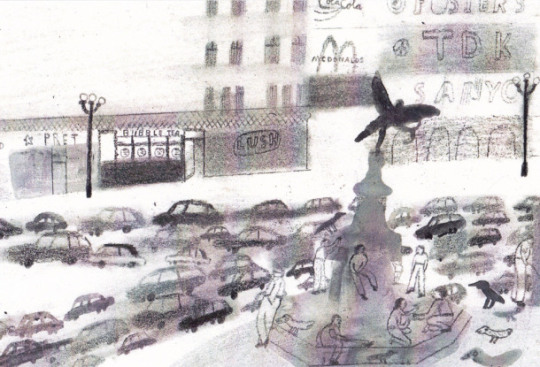

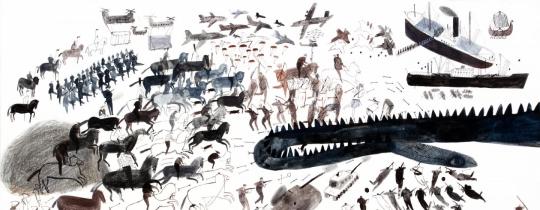
Research: Show and Tell Project
Frank Frazetta
Frank Frazetta was an American illustrator and painter, who became extremely well known for having defined the look, of the character Conan the Barbaro, created by Robert. E.Howard in the 1930s.
Frank was born in Brooklyn, New York, and from an early age he showed his skills as an artist. As a child, at the age of 8, he studied at a small art school called Brooklyn Academy of Fine Arts.
His illustrations are inspired by the great painters of the late 18th and 19th centuries, who portrayed mythological legends.
For me it’s not just the wonderful color palette he used, the wild and original streak or the phenomenal technique he developed. Of course, these things are fundamental, but in my understanding, the most important thing is that he defined practically everything we know in terms of visuals, mainly in the fields of fantasy, witchcraft, barbarism and even a little bit of science fiction.
His paintings defined some characters that we know today, like Tarzan and John carter, that he brought a new life to the characters of Burroughs, not to mention the images of Conan, who made the illustrator famous. Imagine that before him, the Sword and Sorcery look did not exist. The Conan that appeared on the covers of books since the 30s of the last century gets to laugh today. Frazetta was the first to understand the world created by Robert E. Howard.
The reason I chose frazetta as a reference is because I like fantastical worlds so much, and I love to learn anatomy, and frazzetta understood a lot of that, with his extremely vibrant colors, and extremely strong characters, who faced terrible monsters, who disturbed the peace.
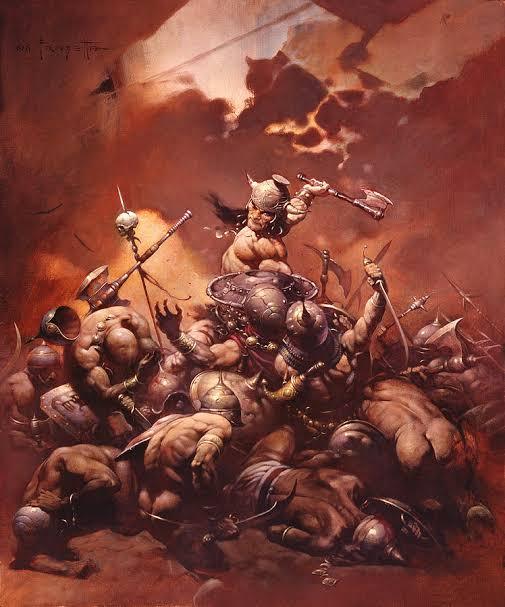
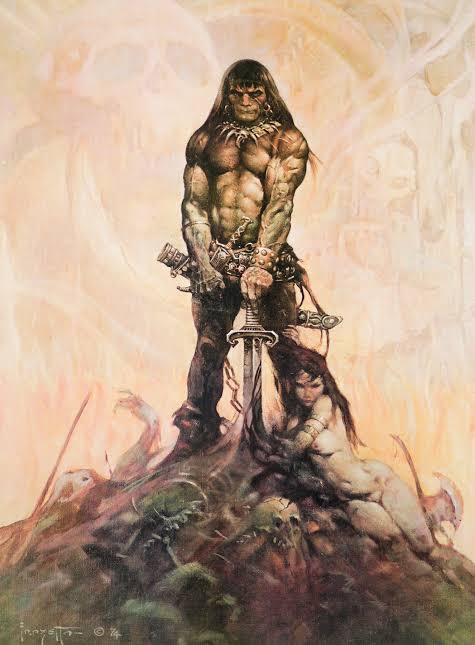
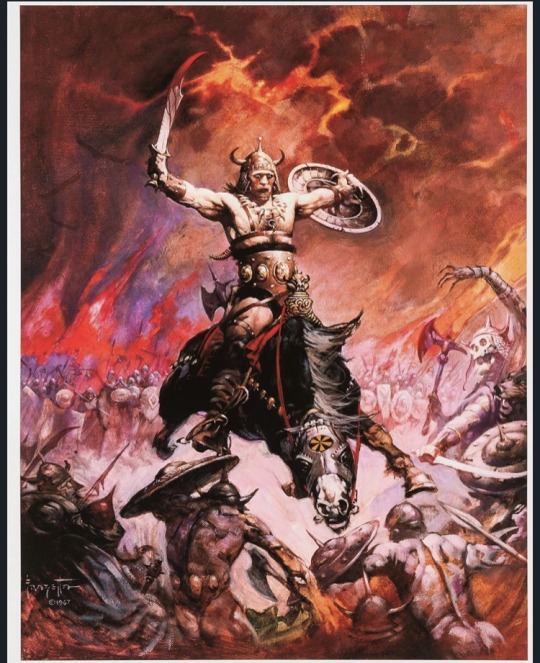
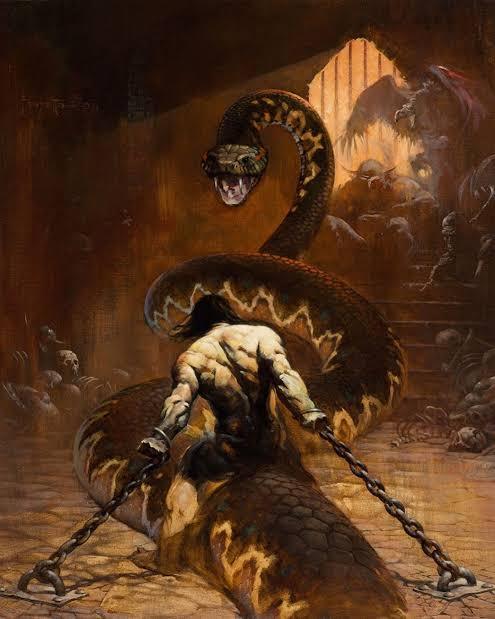
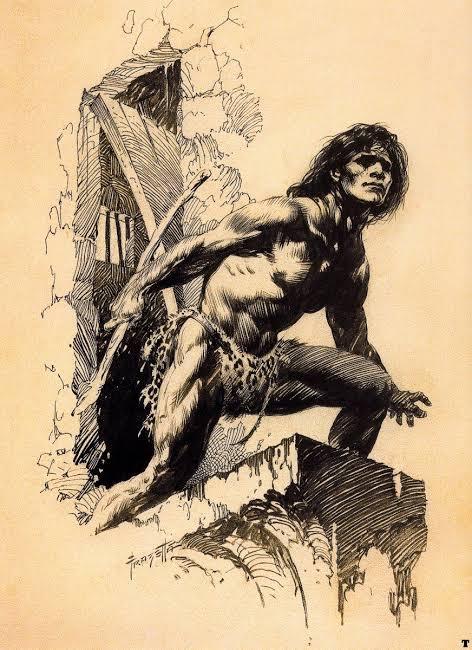
Claude Monet
Claude Monet is the main and most dedicated representative of the impressionist movement. He always preferred paintings outdoors, regardless of weather conditions,in order to capture all the effects of nature. Early in his career he was misunderstood, especially by his family, resulting in financial difficulties for years. Only around the age of 40 did he start selling his paintings, he died as a rich and well known artist.
He started to paint from a very young age which earned him some money, selling caricatures, with the money he bought painting materials. In 1858 he met Eugene Boudin, a landscape painter who encouraged him to paint outdoors. The following year he moved to Paris to specialize his techniques. At that time Paris attracted the most varied artists in the world and there Monet met Camille Pissarro and Manet among other avant-garde artists.
In 1874, the first impressionists exhibition was held in Paris, featuring works by Monet, Renoir, Degas and Cezanne. The term Impressionism, derives from Monet’s painting called Impression, Sunrise (1872).
It was the art critic Louis Leroy to call the artistic movement: Impressionism. It was a way of understanding this type of painting that did not follow the standards established by the academy and its realistic paintings.
When looking closely at an impressionist work, you see only separate brushstrokes that look like blotches without contour. Seen from afar, the brushstrokes organize for our eyes creating shapes and luminosity.
His works of art followed, as a main theme, the landscape of nature.
He worked harmoniously with colors and lights, creating beautiful and strong images. In the artistic context, is good to mention the series of paintings that he made on the Cathedral of Rouen (1892-1894), where the artist portrayed the constructions at different times of the day, with variations in brightness.
Monet and the impressionist artists, were no longer interested in themes related to the nobility, to the church, or to producing portraits that were true to reality. They wanted to see the painting as work in itself.
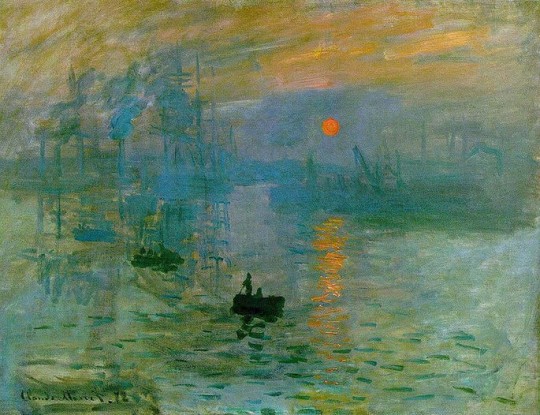
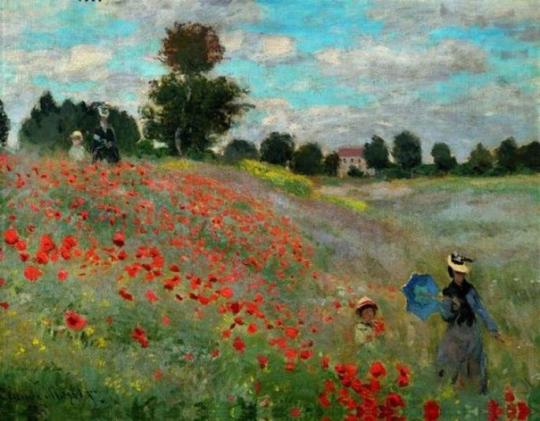
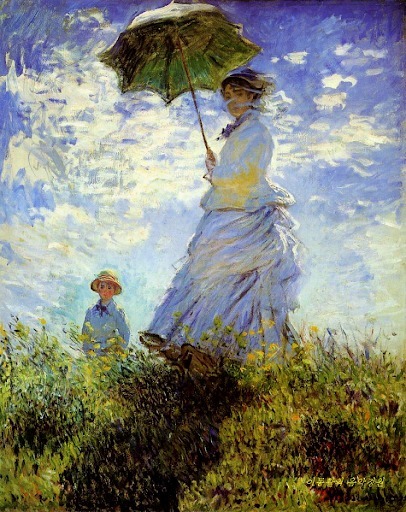
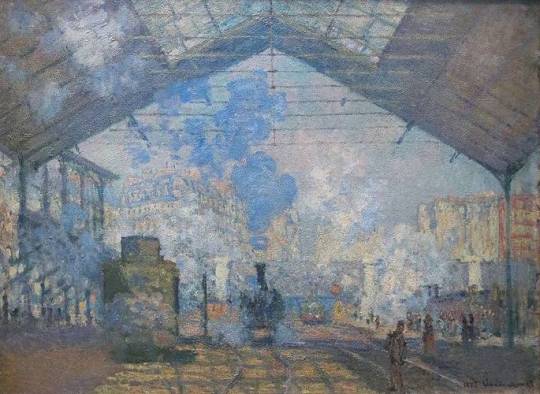

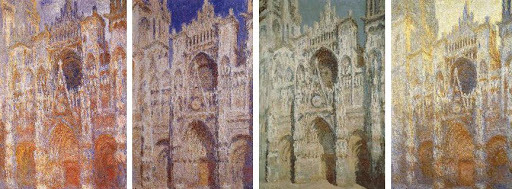
Ridley Scott
Ridley Scott is one of the most well-known film directors of all time. He made several films of different genres, but his most well-known genre is science fiction, making films like Alien, Blade Runner, The Martian and Prometheus.
But before before of being a director, Scott was applying to the Royal College of Art, one the most acclaimed art colleges at the time, to be a designer.
Scott always liked drawing , but he saw that he had no way of being a painter. His teachers always argued that his paintings were more illustrations than paintings.
So he saw that the Royal College of Art, had a particularly strong Graphic Design Department, which would give him a more specific creative target and a broader canvas. He was accepted by the college, and started his studies in 1958 and finished in 1961.
In his words, he considered design college to be extremely competitive, everyone in his class tried to compete with each other to see who was better. And Scott realized that he needed to fight hard to be among the best. “It could be very competitive, with no much being given away and everything kept close to you chest. You observed all the time, watched everyone else did and tried to do better and be the most original”.
Since graduating, Scott has said that he has become extremely perfectionist, and has tried to do as much of his work as a designer and a filmmaker in the best possible way.
After working as a set designer, and director in British television, he began in 1967 to direct commercials, eventually numbering more than 2,000 for his own company. His attention to visual stylization in his commercials, including distinctive atmospheric lighting effects, continued into the feature films that he began to directing in 1977.
In 1979 Ridley Scott releases what is considered his debut film and his masterpiece, the movie Alien. Starring Sigourney Weaver as Ellen Ripley, Scott is credited with having a heroine take point in the ensuing hunt aboard the Nostromo spaceship. Scott’s paintings and illustrations are close to pointillism with tiny points that result in images of high definition and extreme detail.
A highly detailed approach marks his style. His eye for composition, lighting, and design seems to explain his ability to visualize a movie in his mind. He claims to have and eidetic memory and the ability to recall images with high precision.
https://www.youtube.com/watch?v=tjD82nKybUA


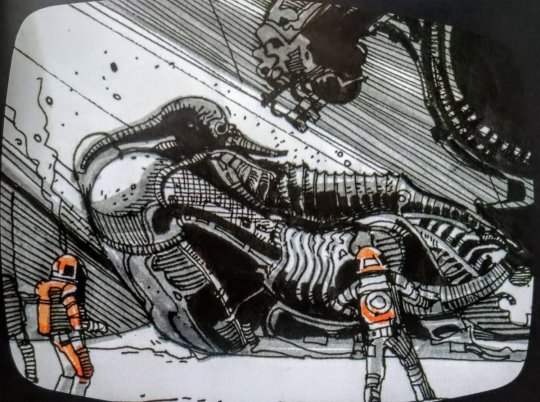
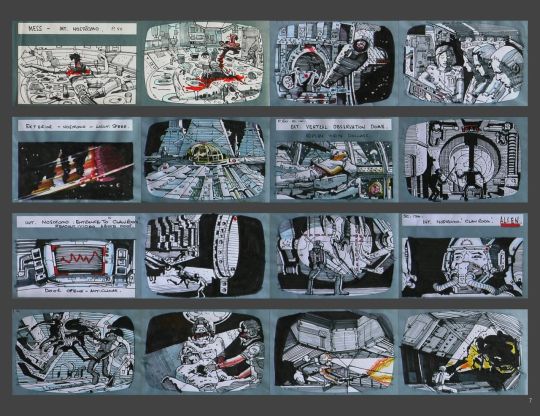
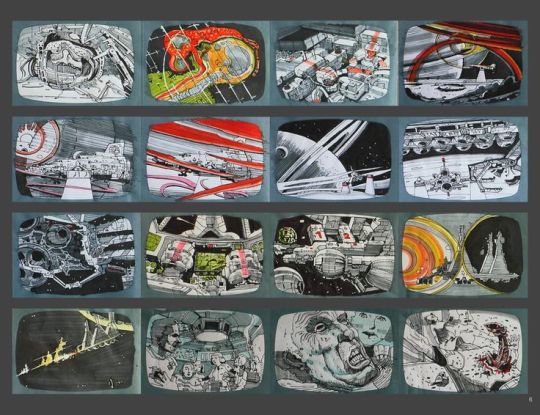
Roxie Vizcarra
Roxie Vizcarra is an artist, who worked as the senior illustrator of Rockstar Games, who worked closely on the iconic Grand Theft Auto v and Red Dead Redemption 2 marketing campaigns.
The Peruvian-American artist was just out of college- she earned her bachelor’s degree from the Parsons School of Design in New York- when she was approached by Rockstar games in 2009.
Vizcarra was Rockstar game’s first female illustrator. The first project she worked on was Grand Theft Auto IV: Liberty City.
The first game Vizcarra worked on since its inception was the original Red Dead Redemption, released in 2010.
Vizcarra draws her art from spaghetti western movies and holds the work of “Golden age” illustrators such as Bob Peak and Robert McGinnis in high regard.
For most of her career, Vizcarra’s process began by drawing in sketchbooks (she’s a fan of traditional ink), which she then uploads and adds digital colors through Photoshop.
However, for a year or two she has been using Procreate on the IPad, which is very flexible for her purposes. She also takes references photos when she doesn’t have a clear idea of what the illustration should look like, either of others or of herself, in the desired pose.
Vizcarra shows unusual humility; she insists on not taking credit for herself and repeatedly refuses to attribute specific drawings to one person or another, or to go into the why’s and how’s of illustrations.
Vizcarra’s work is really interesting, and it explores the more of the side of markenting. In making covers and posters extremely flashy for the public, and in addition to using references to posters from old western movies, maybe that is what attracts me the most. I really like the western theme, and I always liked the way she created the poster for games like red dead redmeption 2 and GTA, with extremely warm colors, with references of very old artists, who perhaps few remember, but she always tries to put some of them into her work.
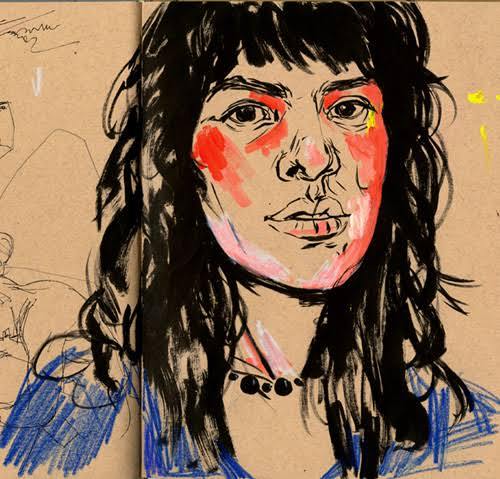
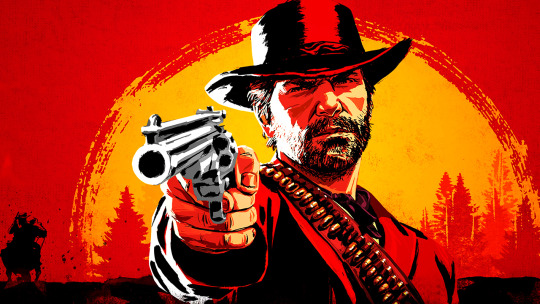
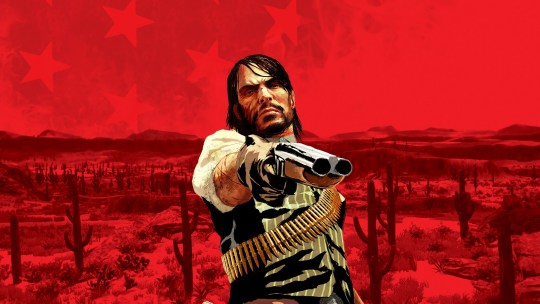
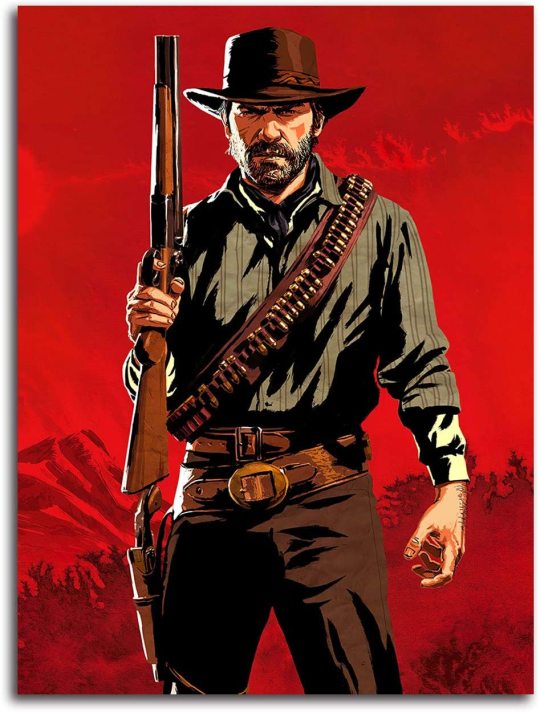
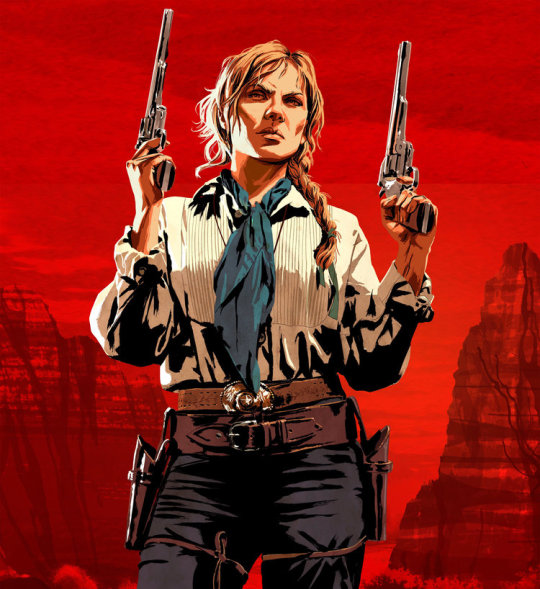
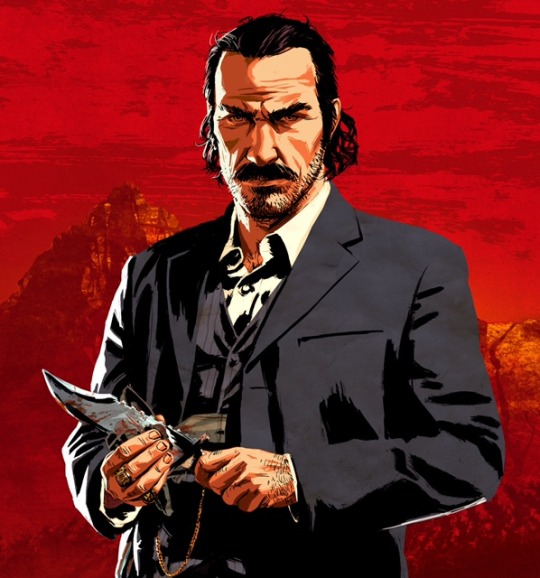
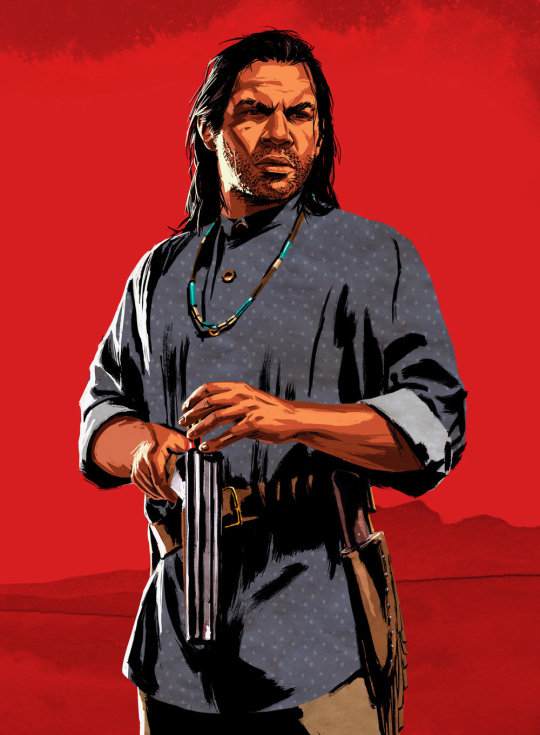
Show and Tell Digital Collage research
Terry Gilliam
Is a famous American-British director, screenwriter, animator, artist and comedian, and who is known for directing and acting in some of the films of the English comedy group Monthy Python, in addition to making films that are extremely difficult to understand, as if madness were the main character in all his films.
Terry Gilliam began his career as an animator and photographic cartoonist; one his first jobs was for the Help ! Magazine.
Gilliam preferred cut-out animation, which involved pushing bits of paper in front of camera instead of photographing pre-drawn cels. The process allows for more spontaneity than traditional animation along with being comparatively cheaper and easier to do. He also preferred to use old photographs and illustrations to create sketches that were surreal and hilarious.
Gilliam was one of the founders of Monty Python. At first, he was accredited as an animator ( his name appeared separate from the remaining 5 members in the credits), later he also joined the series as an actor. Their animations linked the sketches of the program and defined the group’s look in other types of media ( such as Vinyl discs, book covers and the opening sequence in the films).
Gilliam polished a unique style, created fantastic worlds, worked with great stars for the biggest studios, and sweated tight budgets to execute his vision, not always sharp but always brilliant.
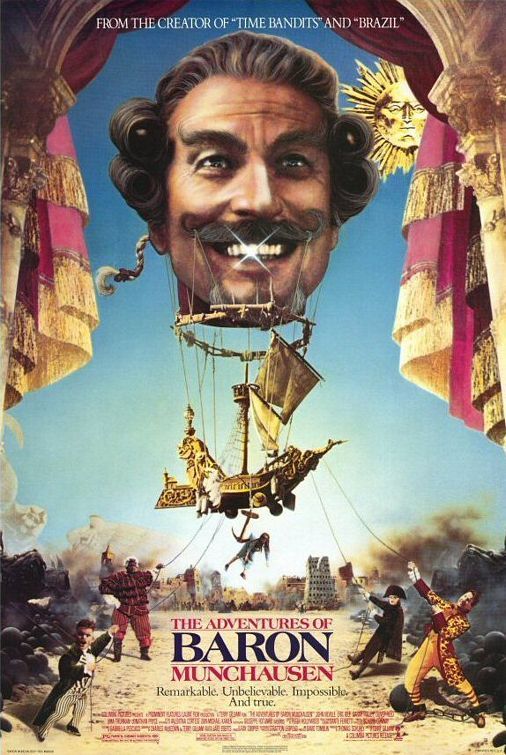
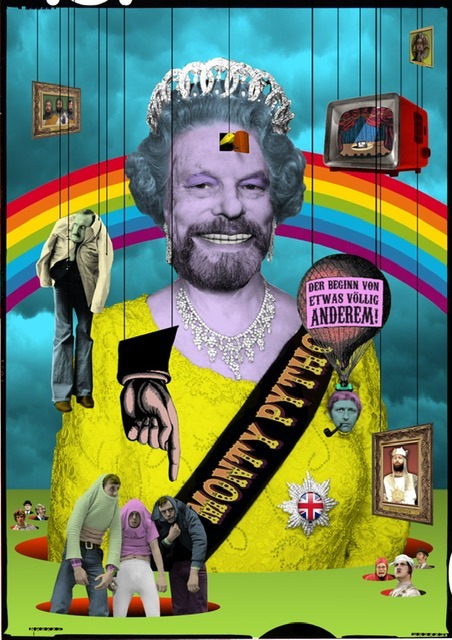
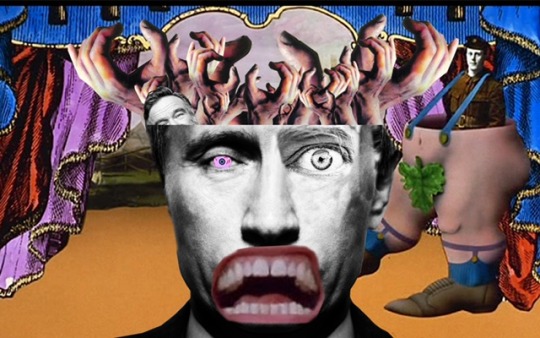
Caco Neves
Caco Neves uses digital collage as a platform, he created, for the past 10 years, illustrations for zines, magazines, advertising pieces, vignettes for TV and the web and, more recently, he was summoned by the Vogue art team to create the cover for the Vogue Experience 2017.
After spending a season in London, where he learned to give movement to his creations with the techniques calls Motion Collage, Caco returned to Brazil and, in a moment of creative rest, when he was creating for himself and not for a client, worked on a psychedelic vignette, then he sent it to MTV, to see if they liked the style, and they asked to use this commercial but to make some adjustments.
For Caco, the success of digital collage in the last decade is a reflection of the time we live in. “ The internet brought access to images- digital collections became public- and photoshop became popular.”
He has worked for several national and international companies, and his work is very dear to his collaborators, very much for his creativity, and for the choice of technique.

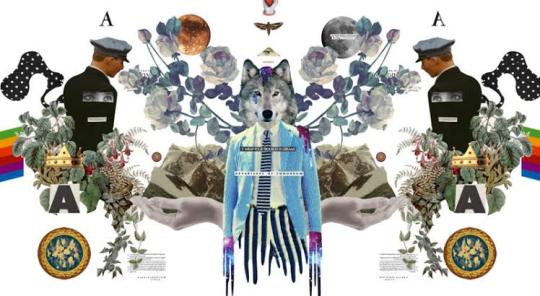
0 notes
Text
Teaching children to read
Learning to read is one among the foremost important things a toddler will neutralize his or her life. That’s because we sleep in a society during which literacy skills are the key to success. When reading ability doesn’t develop overnight, some parents and educators worry they're on the incorrect path to instruction.
But choosing the “right” books and therefore the “best” thanks to teach reading depends on every child. No two individuals will master reading at an equivalent time or pace, and patience and persistence may be a must, particularly for teenagers who struggle with learning difficulties or differences.
Teaching a toddler to read begins at birth with the reinforcement of pre-literacy skills. Nonetheless, most youngsters will officially learn to read between the ages of 5 and seven .
One of the foremost common ways to show reading is via the sounding out method during which kids are encouraged to read aloud, pronouncing each letter or group of letters until they recognize the word by sound.
At an equivalent time, educators will teach sight words, or common vocabulary that children can memorize so as to scale back the cognitive burden of decoding sentences. the idea is that the less words children got to sound out, the more attention they need to process a greater number of terms and understand vocabulary they need never encountered before.
As kids become strong readers, they are doing less and fewer reading aloud and recognize more and more vocabulary by sight. This makes them faster. they will also do more when it involves interacting with the books they're reading, including following more complicated narratives, understanding specific details, gist and making inferences and predictions.
They grow their vocabulary because reading introduces them to new words they will understand from context. Moreover, reading impacts on writing ability. Kids develop familiarity with more sentence structures and start to use and adapt them to precise themselves. this is often an important skill which will serve them altogether areas of the curriculum, from English class to social studies.
Pre-literacy skills
There are certain pre-literacy skills educators have identified as important in preparing kids for reading instruction. Children can speak their language , but they'll not always recognize the component phonemes that structure English vocabulary.
Silly songs and rhymes can help call their attention to the “Sssss” or “shhh” sounds they’ll got to accompany letters so as to read their first words. they need to learn the alphabet in fact , but reading books also relies on grasping the concept of narrative.
This is something parents can teach by asking kids to recall actions within the order during which they occurred or just leading by example and rehearsing the day’s activities with them.
Parents also are encouraged to read to their children because fostering a love of books begins reception . Very young children might not understand what you're reading but they're going to become conversant in how books work, including distinguishing print from pictures.
Infants like to imitate adults and turning pages may be a good way to practice their fine motor skills and pincer grasp. If reading becomes a routine, they’ll begin to expect fun and entertaining stories. Positive associations forged through ample quality time spent with their parents will help them be more curious about reading books on their own.
How to teach reading - use one word per card
How to teach reading
Phonics
Reading requires bringing together a child’s knowledge of the audio system of his or her language and therefore the letters and letter combinations that represent different phonemes. For this reason, some phonics instruction is important .
Familiar words
Because they're fluent speakers, kids have a base vocabulary to start with. That’s why learning the way to read words they're already conversant in may be a good place to start out . This might include their own name and other concrete nouns which will be prompted using pictures.
One word at a time
In the beginning, an excessive amount of text are often overwhelming for a replacement reader. confirm there aren't too many words on a page and begin by having them sound out single terms before getting to phrases and sentences.
Ample exposure and much of repetition
Reading words that contain an equivalent letters and letter combinations and seeing those words multiple times helps kids practice early reading skills. Did you recognize that 50-75% of the words in most children’s books come from the Dolch list?
Illustrations and large print
Images can help a toddler within the beginning by prompting him or her to acknowledge the word they're reading. It helps if words are large enough and printed in bold, easy to read font.
High frequency vocabulary
Memorizing words that are likely to point out up in most books for youngsters helps reduce the cognitive load related to sounding out phrases and straightforward sentences. Kids can use flashcards and practice spelling at an equivalent time.
Books they need to read
Children are often more motivated to read if they're curious about the fabric to start with. Take kids to the library and allow them to select the books they need to start out with. If the text proves too challenging, a minimum of you've got a thought of what topics they're curious about .
Taking on a challenge
Starting with books that are too hard are often discouraging for an early reader. Keep kids motivated by selecting a mixture of easy material that's at their level, interspersed with challenging books that are one step beyond. an honest thanks to tell how hard a book is by having the kid read a page and lift a finger for each word they don’t recognize. If any page contains quite 5 words the kid doesn’t know, save the book for later.
Read More how to teach a kid to read
Graded readers
Many English novels and stories are adapted for readers of various levels. inspect graded readers and check out using several levels in progression to make sure familiar vocabulary and a uniform increase in difficulty.
Constructs and interaction
It’s an honest idea to encourage active vs. passive reading by asking children about what they need read. within the beginning they're going to be focused on recognizing words but afterward they’ll got to get the gist of the text and be ready to tell you more about the small print too!
0 notes